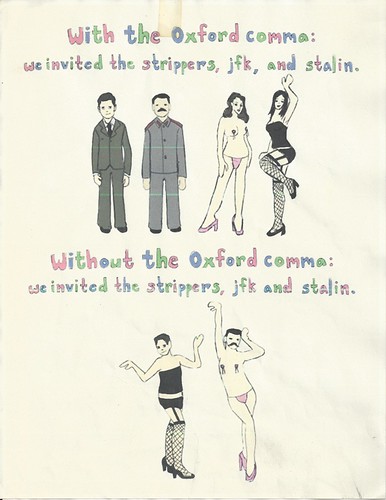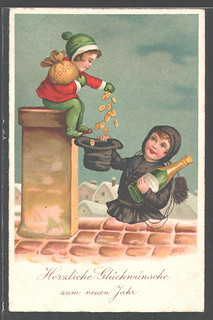
About UsThe Numismatic Bibliomania Society is a non-profit organization promoting numismatic literature. For more information please see our web site at coinbooks.org SubscriptionsThose wishing to become new E-Sylum subscribers (or wishing to Unsubscribe) can go to the following web page link MembershipThere is a membership application available on the web site Membership Application To join, print the application and return it with your check to the address printed on the application. Membership is only $15 to addresses in the U.S., $20 for First Class mail, and $25 elsewhere. For those without web access, write to: David M. Sundman, Treasurer AsylumFor Asylum mailing address changes and other membership questions, contact David at this email address: dsundman@LittletonCoin.com SubmissionsTo submit items for publication in The E-Sylum, just Reply to this message, or write to the Editor at this address: whomren@gmail.com
BUY THE BOOK BEFORE THE COIN |
- WAYNE'S WORDS: THE E-SYLUM JANUARY 5, 2014
- KOLBE & FANNING NEW YORK BOOK AUCTION SATURDAY JAN. 11
- LAKE BOOKS NUMISMATIC LITERATURE SALE CLOSES FEBRUARY 4, 2014
- NEW BOOK: HUNGARIAN TRANSPORTATION TOKENS
- NEW BOOK: OTTOMAN EMPIRE & TURKISH REPUBLIC TOKENS
- NEW BOOK: CATALOGUE OF BRAZILIAN TOKENS ADDENDUM
- COIN BOARD NEWS WINTER 2014 ISSUE PUBLISHED
- THE ADAM MERVIS LARGE CENT COLLECTION
- HOWARD DANIEL ON BUILDING A NUMISMATIC LIBRARY
- SOMETIMES YOU DON'T HAVE TO SEE THE COIN
- ARTISTIC STYLE REVEALS MAKER OF SANSOM MEDAL RESTRIKE
- AMSTERDAM'S ROYAL TROPICAL INSTITUTE LIBRARY CLOSES
- NOTES FROM E-SYLUM READERS: JANUARY 5, 2014
- STILL MORE ON THE SERIAL COMMA
- STEVE D'IPPOLITO ON NOVODELS AND FANTASY PIECES
- THOMAS SULLY'S INFLUENCE ON U.S. COINS AND CURRENCY
- ADVENTURES IN PUBLISHING COIN BOOKS
- THE 1763 CHARLESTOWN SOCIAL CLUB MEDAL
- THE SYDNEY MINT MEDALLION OF 1901
- ROBERT HEATH'S NEW ENGLAND MEDAL CATALOGS
- THE DEERFIELD, MONTANA HORSE CAR TOKEN
- KANKAKEE AND LYDIA, THE TATTOOED LADY
- THE 1954 “DEVIL’S FACE” CANADIAN BANKNOTES
- SCHWUNDGELD: THE DEPRESSION SCRIP OF WÖRGL, AUSTRIA
- THE BIRTH OF THE GREENBACK
- AN INTERVIEW WITH AUTHOR WAYNE SAYLES
- REVEALING THE LOST CODEX OF ARCHIMEDES
- THE HOBO NICKEL CARVINGS OF PAOLO CURCIO
- THE DESIGN OF MODERN BRITISH COINS
- SELECTIONS FROM THE STACK'S BOWERS JANUARY 2014 NYINC AUCTION
- PRIVATE SCHULZ INSPIRED BY OPERATION BERNHARD
- WARREN COUNTY PA'S WINTERFEST 2014 COIN
- TEENAGER FIRST AGAIN AT ROYAL AUSTRALIAN MINT IN 2014
- THE AUSTRIAN MINT'S "PROSIT NEUJAHR" TOKENS
- FEATURED WEB PAGE: WRONKER PRINTING MEDAL COLLECTION
Click here to access the complete archive
To comment or submit articles, reply to whomren@gmail.com
WAYNE'S WORDS: THE E-SYLUM JANUARY 5, 2014

New subscribers this week include Dale Hallmark, courtesy of David Powell; and Werner Stensgard. Welcome aboard! We have 1,680 email subscribers.
This week we open with updates from numismatic booksellers Kolbe & Fanning, and Lake Books, followed by three new numismatic books. Other topics include building (and properly disposing of) a numismatic library, novodels and fantasy pieces, Thomas Sully's influence on U.S. coinage, and the Birth of the Greenback.
To learn more about the Tattooed Lady, the Queen's Hair-Devil, Schwundgeld, the elusive Deerfield, Montana horsecar token, Hungarian transportation tokens, the Wronker printing medal collection, and the lost codex of Archimedes, read on. Have a great week, everyone!
Wayne Homren
Editor, The E-Sylum
KOLBE & FANNING NEW YORK BOOK AUCTION SATURDAY JAN. 11
Kolbe & Fanning Numismatic Booksellers are holding their annual New York Book Auction this Saturday, January 11, beginning at 9:30 a.m. Eastern Time. The two-session public auction sale of rare and important numismatic literature is being held in conjunction with the 2014 New York International Numismatic Convention (NYINC) at the Waldorf-Astoria Hotel in New York City. Live online bidding will be available through www.the-saleroom.com .
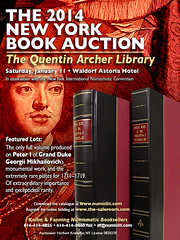 During the first session, the firm will be offering selections from the remarkable library on Russian numismatics formed by Quentin Archer. The Archer library is especially strong in pre-Petrine material and in references on the coins and medals of Peter the Great, with some coverage of later periods. Highlights include works by Tolstoï, Fraehn, Giel, Ilyin, Chertkov, Koehne, Markov, Oreshnikov, Zubov, and the Grand Duke Georgii Mikhailovich. Archer's holdings of important auction catalogues and periodicals are also notable.
During the first session, the firm will be offering selections from the remarkable library on Russian numismatics formed by Quentin Archer. The Archer library is especially strong in pre-Petrine material and in references on the coins and medals of Peter the Great, with some coverage of later periods. Highlights include works by Tolstoï, Fraehn, Giel, Ilyin, Chertkov, Koehne, Markov, Oreshnikov, Zubov, and the Grand Duke Georgii Mikhailovich. Archer's holdings of important auction catalogues and periodicals are also notable.
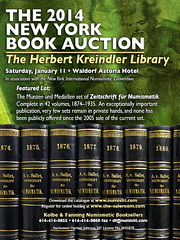 Beginning at noon, Kolbe & Fanning will be offering highlights from the outstanding and comprehensive library on ancient numismatics formed by New York coin dealer Herbert Kreindler. This part of the sale is being conducted in association with Fritz Rudolf Künker GmbH, of Osnabrück, Germany. The Kreindler library is well-known for its extensive nature, including original editions of virtually all of the key works on ancient Greek and Roman coins. His collections of classic auction catalogues and periodicals must also rank among the finest offered in recent years.
Beginning at noon, Kolbe & Fanning will be offering highlights from the outstanding and comprehensive library on ancient numismatics formed by New York coin dealer Herbert Kreindler. This part of the sale is being conducted in association with Fritz Rudolf Künker GmbH, of Osnabrück, Germany. The Kreindler library is well-known for its extensive nature, including original editions of virtually all of the key works on ancient Greek and Roman coins. His collections of classic auction catalogues and periodicals must also rank among the finest offered in recent years.
Printed catalogues were mailed in early December to active clients. PDFs of the two catalogues are available for downloading from the Kolbe & Fanning website at www.numislit.com. Live internet bidding is available through the-saleroom.com, on which site every lot is illustrated in color. As Kolbe & Fanning staff will be traveling to New York, absentee bids must be received in their Ohio office by Monday, January 6. To place absentee bids after that date, please email David Fanning at df@numislit.com or call him at (614) 256-8915. Absentee bids cannot be accepted on the day of the sale. For more information, see the Kolbe & Fanning website at www.numislit.com.
Kolbe & Fanning Numismatic Booksellers LLC
141 W. Johnstown Rd.
Gahanna, OH 43230
(614) 414-0855
Cell (614) 256-8915
Fax (614) 414-0860
df@numislit.com
www.numislit.com
Members ANA, ANS, IAPN
LAKE BOOKS NUMISMATIC LITERATURE SALE CLOSES FEBRUARY 4, 2014
Lake Books’ next mail-bid sale of numismatic literature has a closing date of February 4, 2014 at 5:00 PM (EST). The 469-lot offering has a fine selection of hardbound sale catalogs from major auction houses, scarce early plates from notable collections, wonderful Chinese numismatic reference material, works on paper money, tokens & medals, an especially long run of the hardbound renditions from George F. Kolbe, et al. You may view the catalog on our web site at www.lakebooks.com/current.html. Bids may be sent via US Mail, email, Fax, or telephone until the closing.
Good Luck with your bids, Fred
Lake Books
PMB 118
6822 22nd Ave. N
St. Petersburg, FL 33710-3918
727-343-8055 fax: 727-381-6822
NEW BOOK: HUNGARIAN TRANSPORTATION TOKENS
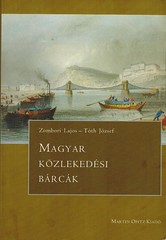 I recently received a fine book exactly in our field: Zombori Lajos & Tóth József, "Magyar közlekedési bárcák" , Budapest, 2007, 237 pp. This book on Hungarian transportation tokens has eight chapters as well as an introduction in English and a Hungarian-English dictionary of important words that describe the tokens and legends.
I recently received a fine book exactly in our field: Zombori Lajos & Tóth József, "Magyar közlekedési bárcák" , Budapest, 2007, 237 pp. This book on Hungarian transportation tokens has eight chapters as well as an introduction in English and a Hungarian-English dictionary of important words that describe the tokens and legends.
The chapters are as follows: Introduction, Toll Bridge Tokens, Tunnel Tokens, Toll Road Tokens, Fare Tokens and Tickets, Transportation Deposit Tokens, Telephone Tokens and Bibliography. Almost every piece is illustrated with good black and white photographs. Highly recommended for anyone who includes Hungarian tokens in their collection.
NEW BOOK: OTTOMAN EMPIRE & TURKISH REPUBLIC TOKENS
 Ottoman Empire & Turkish Republic Tokens
Ottoman Empire & Turkish Republic Tokens
Number of printing : 300
(bilingual : turkish/english)
130 gram premium paper
300 pages (148x210mm)
Full color
Soft Cover, Library Binding
For the first time ever, whole Ottoman Empire & Turkish Republic tokens in one catalogue.
- 2545 Tokens
- 2545 Photographes
- Weight, size, material and rarity of each token
- Transportation Tokens
- Communication Tokens
- Game Tokens
- Shopping Tokens
- Food & Beverage Tokens
- Military Tokens
- Prison Tokens
- Community Tokens
- (Jewish, Armenian, Muslim Communities)
- Daily Wage Tokens
- Newspaper Tokens
- Miscellaneous Tokens
To read the complete eBay description, see: NEW * Ottoman Empire & Turkish Republic Tokens Catalogue (www.ebay.com/itm/NEW-Ottoman-Empire-Turkish-Republic-Tokens-Catalogue-/321150243395)
To visit the seller's web site, see: Osmanlı İmparatorluğu ve Türkiye Cumhuriyeti Jetonları Kataloğu 2013 (www.osmanliparalari.com/Osmanli-Imparatorlugu-ve-Turkiye-Cumhuriyeti-Jetonlari-Katalogu-2013,PR-14847.html)
NEW BOOK: CATALOGUE OF BRAZILIAN TOKENS ADDENDUM
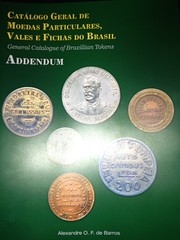 General Catalogue of Brazilian Tokens, Addendum
General Catalogue of Brazilian Tokens, Addendum
By Alexandre de Barros
An Addendum to the General Catalogue published in 2009 is now available to collectors and researchers of Brazilian tokens. The bilingual edition (Portuguese-English) is limited to 200 numbered and signed copies and contains more than 500 types. The book has 210 large-format pages. Most tokens are illustrated by colour photographs.
As in the original Catalogue, the descriptions of the tokens are accompanied by a table showing degrees of rarity and prices, in addition to annotations containing information about a large number of types.
The price of the book is $80.00 plus shipping . For additional information interested collectors should contact the author at alexdebarros2@gmail.com
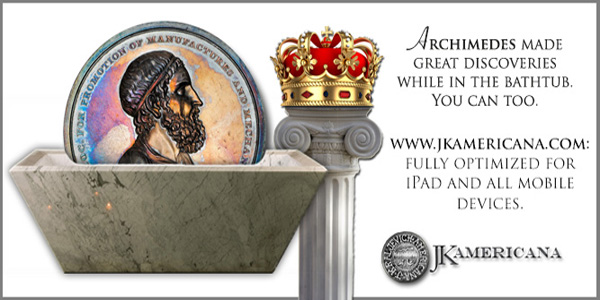
COIN BOARD NEWS WINTER 2014 ISSUE PUBLISHED
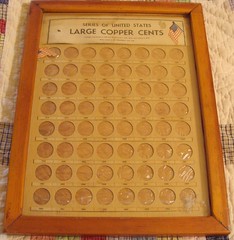 My latest book has been in print for a couple of months now, and the
reviews have been extremely gratifying. I was surprised that two reviews appeared very quickly on Amazon, and I
don’t know who the writers are. Despite nothing but praise for the book, sales have been a bit slow. This is
something I’ve been hearing from numismatic booksellers about all titles, so I’m not too concerned for now. The
book’s price does deter the casual buyer, but there’s really no substitute for the information presented, and the book
is by far the finest I’ve ever produced in terms of graphic quality.
My latest book has been in print for a couple of months now, and the
reviews have been extremely gratifying. I was surprised that two reviews appeared very quickly on Amazon, and I
don’t know who the writers are. Despite nothing but praise for the book, sales have been a bit slow. This is
something I’ve been hearing from numismatic booksellers about all titles, so I’m not too concerned for now. The
book’s price does deter the casual buyer, but there’s really no substitute for the information presented, and the book
is by far the finest I’ve ever produced in terms of graphic quality.
Perhaps a few interested persons are waiting for one of the discount houses to offer it at a lower price, but this is simply not going to happen. I’m the publisher and sole source of this title. It may be purchased through my listings on Amazon and eBay, or you may order it from me directly. Of course, this last option is preferable for me, as I don’t have to share any revenue with the big boys.
In an interesting side note, my ads for the new album book have resulted in more sales of the earlier coin board book than I’ve had in a long while. My mailing list of board collectors and potential collectors has grown considerably.
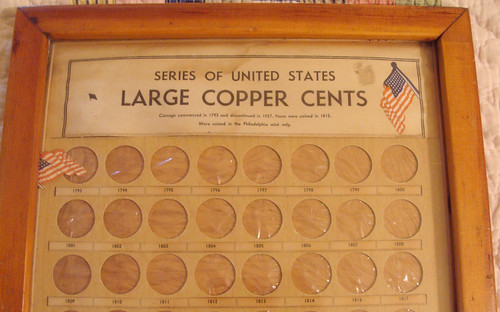
[An] interesting item I acquired for myself was a framed, homemade coin board for large cents that was evidently produced during the late 1930s. I’m attaching the eBay seller’s photo, and I’ve since re-pasted the fallen flag back into its correct position. With the glass given a thorough cleaning, this item really looks nice.
For more information, see: www.coincollectingboards.com
To read the earlier E-Sylum articles, see:
LANGE'S COIN COLLECTOR BOARD BOOK ARRIVES
(www.coinbooks.org/esylum_v10n38a07.html)
NEW BOOK: THE NATIONAL COIN ALBUM AND RELATED PRODUCTS
(www.coinbooks.org/esylum_v16n41a04.html)
THE ADAM MERVIS LARGE CENT COLLECTION
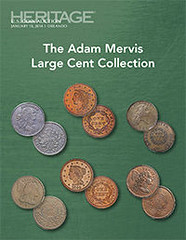 Heritage Auctions is proud to present The Adam Mervis Large Cent Collection, to be sold January 10 in conjunction with the Official Auction of the 2014 FUN Annual Convention.
Heritage Auctions is proud to present The Adam Mervis Large Cent Collection, to be sold January 10 in conjunction with the Official Auction of the 2014 FUN Annual Convention.
Assembling a complete set of the 295 Sheldon-numbered varieties, with the nine additional sub-varieties, is among the greatest achievements of large cent collecting, a feat accomplished by only a handful of masters in the field. Adam Mervis accomplished that goal and then some.
Not only did Adam Mervis collect all the Sheldon varieties, including the legendary and extremely rare 1795 S-79 Reeded Edge cent, he also assembled a fine array of the Non-Collectibles as well, 39 coins representing 35 of the 53 NC varieties. How many collectors can claim to have owned two Strawberry Leaf cents at once? The Adam Mervis Large Cent Collection contains both the unique NC-2 variety and the second-finest NC-3, one of just three known examples. The 1794 NC-10, a Head of 1794 variety, is another unique piece within these pages. In fact, the 1794 large cents include every variety and sub-variety, both numbered and NC. This is only the third time that a complete set of the 69 coins has appeared in a single auction.
The Adam Mervis Large Cent Collection continues with a magnificent run of Middle Date and Large Date pieces, circulation and proof alike, including some of the rarest Newcomb varieties. Highlights here include the finest known 1818 N-4 Coronet cent, a Condition Census-worthy proof 1838 N-11 cent, and the finest of seven known 1849 N-25 cents. A handful of special error coins also are present, including a twice-struck 1798 S-149 cent that also happens to be Condition Census-worthy for the die pair.
To view the online catalog, see: 2014 January 10 The Adam Mervis Large Cent Collection FUN Signature Auction - Orlando #1200 (coins.ha.com/common/auction/catalog.php?SaleNo=1200&ctrack=2765472)
HOWARD DANIEL ON BUILDING A NUMISMATIC LIBRARY
I started collecting Southeast Asian numismatic pieces in 1964. Very few world numismatic references were available to buy back then. Even fewer were about Southeast Asia, and I bought them. I also bought non-Southeast Asian references with formats I liked, because I planned to someday start writing my own references.
While overseas in the Army, I kept little with me, especially during my six years in the Vietnam War. I mailed everything to my mother to store for me. I told her that all nonregistered mail was for her and all registered was for her to store for me. My time overseas and in the Vietnam War ended in January 1973.
I was a student/assistant instructor in an Army school when my wife, Phung, arrived in the United States in February. To give her something to do, I had all of my stuff stored at my mother’s home shipped to me. Phung could go through the contents and sort them down for me.
I graduated and was assigned to a research job in Reston, Va. I had bought a large used station wagon, but our stuff barely fit inside it when we drove off from Indiana.
We rented an apartment and went shopping for some furniture. Phung did not want us to go into debt, so we bought a sleep sofa. We used a large cardboard box for our dining table and sat on flattened boxes. Each month we bought one or two more pieces of furniture for cash. Two of them, eventually, were bookcases, which quickly filled up.
Later, I had an office desk and a third bookcase. One day I came home and a used IBM Selectric Typewriter was on a stand next to my desk. Phung told me, since I said I wanted to write my own references, let’s get started! Within two years, I self-published my first catalog in 100 copies. They sold so fast I forgot to keep one and had to buy one back!
I received emergency orders for Germany and while there, bought many more references in European languages, and published another catalog. During some missions in England, I had time in London before my return flight. At one bookstore, I opened a book and found the owner was an author in my library. I asked the bookstore owner how he obtained the book.
He told me that he heard a rumor about him passing away and he contacted his widow. She was about to trash his personal library because a local library refused it. He showed me several boxes of his books and I bought many of them. Those books are still very important references to me and they could have ended up in a dumpster!
After we arrived back in Virginia in early 1979, we had to buy a condo with an extra room for books. The condo cost more but it paid off in the future when we sold it. On Sunday afternoons, we visited used bookstores in the Washington, D.C., area. I found few books for myself but many for other numismatists at only 25 to 50 cents each. The people selling the numismatist’s libraries did not know their value and sold them to junk book dealers. In the numismatic book market, some were worth over $100 each.
To read the complete article, see: A life in the U.S. Army helped in building numismatic library (www.coinworld.com/articles/a-life-in-the-u-s-army-helped-in-building-num)
SOMETIMES YOU DON'T HAVE TO SEE THE COIN
When I wrote "Sometimes you have to see the coin", I forgot to give you the converse: "Sometimes you don't have to see the coin".
In fact, it's often impossible to see the coin. The simplest example I can give is when you're doing a die-link study. Rounding up all the recorded coins for the study is usually impossible - some of them may no longer even exist (destroyed during WWII for example). Die-link work is always done from photographs, to insist otherwise would prevent any work from even starting.
Does this matter in practical numismatic work? - you bet it does. John Sills, an eminent worker in the Ancient British series, did a die-link study of Gaulish gold staters. He noticed that one set of linked coins were only found in Britain. He argued convincingly that these were a British, not Gaulish issue - and identified the earliest known coins struck in Britain in the process.
I know for a fact that Sills never saw two of the coins - they were sitting here in the USA. But he exercised judgment, and decided that he could do the required study in a competent way, working just from photographs. He promptly published an important numismatic finding "without see the coin"....and he got it right.
You'll notice I didn't criticize Wayne Sayles for questioning the coin in Israel. I suspected he was using the converse of the rule. I think Sayles exercised excellent judgment in this case. He has reasonable cause to ask a question about the evidence. The people who presented the evidence should reasonably answer Sayles' question.
Does this matter? Again, you bet it does. Once something become "common knowledge", it's hard to keep the archaeological record straight.
I imagine you'll want the posting "Sometimes you HAVE the coin and doesn't make a bit of difference".
To read the earlier E-Sylum articles, see:
SOMETIMES YOU HAVE TO SEE THE COIN
(www.coinbooks.org/esylum_v16n52a10.html)
NOTES FROM E-SYLUM READERS: DECEMBER 29, 2013 : You Should Always See The Coin
(www.coinbooks.org/esylum_v16n53a09.html)
THE BOOK BAZARRE
ARTISTIC STYLE REVEALS MAKER OF SANSOM MEDAL RESTRIKE
I recently finished working on an article on the 1776 Franklin American Beaver medal that was published in the December 2013 MCA Advisory. In the process of examining all of the medals made by Joseph Sansom, I made an important discovery that I wanted to reveal which was too far outside the focus of my article to include there.
According to Rulau /Fuld in Medallic Portraits of Washington, The Joseph Sansom 1797 Washington Presidency Relinquished medal was first struck approximately 1807 (though possibly as early as 1805) with dies engraved by John Reich. They state that due to the popularity of Washington medals, the medals were re-struck beginning in 1859 at the US Mint using the original obverse dies, and replacement reverse dies. (The popularity of Washington medals at the time is evidenced by the 1860 Washington Cabinet medal (Julian MT-23) showing the display of Washington medals at the US mint – with a wonderful depiction of tiny little Washington medals below a bust statue of Washington.)
On closer examination, the obverse on the restrikes is not struck from the original die. Or an exact copy hubbed from the original die. I am attaching two graphics. The first one shows the two obverses side by side original on the left, restrike on the right. The arrows point to only some of the differences.
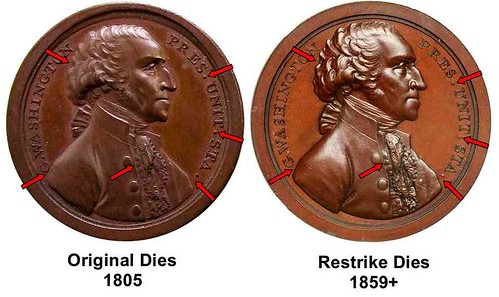
1) The first initial “G.” nearly touches the shoulder of Washington on the original; on the restrike there is a larger gap.
2) The periods after “PRES.” And “UNIT.” are slightly above the base of the lettering on the original; it is lined up with the base of the lettering on the restrike.
3) There is a larger gap between the “STA.”. and Washington’s bust on the originals vs. the restrike.
4) The small top button of Washington’s vest touches or is slightly under Washington’s coat on the original; there is a gap between the same button and Washington’s coat on the restrike.
5) There is a noteworthy indentation in Washington’s hair (peruke) below the “O” of “WASHINGTON” on the original; the indentation is not as deep or sharp on the restrikes – and is positioned between the “O” and the “N”.

The second graphic is a transparent overlay of the original over the restrike. The profile of Washington’s face has been lined up on both. You can see how the lettering is lined up completely different relative to the bust on the original and restrike. Less obvious it is the fact that the two busts do not line up at the shoulder or chest, and the back of the hair line and ribbon does not line up. The two busts are not accomplished using identical proportions and angles. Clearly the restrikes are not struck with original dies, nor are they an exact copy of the original die.
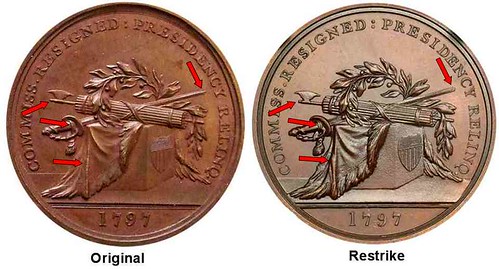
As to the Reverse, Rulau/Fuld have already identified that the “Q “after “RELIQ.” is closer to line of the ground below the pedestal on originals. Earlier, in Julian’s Medals of the United States Mint, Julian stated that “Although Witham points out a sure way of determining an original from a restrike (recutting of the figure 9 in the date 1797) it has been traditional, though less exact, to determine the difference by the distance of the Q in RELIQ from the pedestal; on the original it is closer.”
I don’t necessarily agree with Julian on this point; in fact it is much easier to see the distance of the Q from the line of the ground (not the pedestal as stated) with the naked eye than trying to figure out if the 9 is recut, which requires magnification. On the originals, the Q nearly touches the line; on restrikes there is an easily discernable gap (a little difficult to see on the graphic as the reverse of the image came out a little blurry).
If you take a closer look, you will discover that none of the descriptions of the differences are truly correct. Technically, the Q is not actually closer to the line on the originals – look carefully, the LINE of the ground is LOWER on the restrikes, creating the larger gap. It creates the same difference comparatively, but artistically, the difference is important in that the artist accomplished the design by using a different artistic style with the ground placed lower, not with the Q placed further away.
But it is much easier to tell the difference than simply the “Q” or the re-cutting of the “9“. Which gives me the opportunity to jump on a soapbox. Too often we look at lettering to find differences, something we learned to do from coin collecting. Look at the artistic style! The replacement reverse die is not only different in the placement of the letter Q and the re-cutting of the date.
Take a closer look. It has the same design elements in the same basic location, but it is a copy die, executed by a different artist copying the original. Look back and forth between the original and restrike, and note the fine details of how two different artists accomplish the same design. The arrows in the graphic only show a few of the differences. The date is wider, every single letter is differently placed, the style of the periods differs, the folds of the drapery are different, the fasces axe is different, the length of the staff of the axe beyond the blade is different , the point of the sword is different (and points to a different spot in the lettering), the ferrule of the swords are different, the fringe has different detail, the gaps between the leaves and berries are different, etc. etc. etc. etc. etc. In proportion and angle and style - EVERYTHING is different.
While a pantograph could have been used to create the replacement dies from the original dies or original medals; these are inexact copies. Using a pantograph improperly the details could be muddied, and details can be re-engraved. With no records of the exact process used to make the new dies, we can only look at the medals to figure out what happened. The restrikes are just too far removed from being perfect copies of the originals for them to have been created from a pantograph of the original dies.
Now we know that the original dies were only used to strike the original Sansom Washington Presidency Relinquished medals, and the restrikes are only copies with no lineage to those original dies. I hope that this discovery and examination will cause all of us to take a closer look at everything about the differences between medals (and any numismatic items) struck then re-struck later with the same design elements. No artist can make an exact copy, not even of his own work. Only an entirely mechanical process or use of the same original dies can create a precise copy.
With restrikes of so many historic medals, for too long we have oversimplified the differences between medals. I have seen many examples of this on Betts medals, and US Mint medals where a little effort, research, and computer technology could unveil their secrets. Also for too long, we have ignored historical medals as also being pieces of art, and failed to look carefully at them artistically.
One great example I can give is the previously enigmatic Maryland medals (Betts 34-36). John Adams suspected they were the work of Thomas Simon from their style. I looked through all of the British medals made at the time by Simon and everyone else, and Simon has a very distinctive style matching the Maryland medals. This made me absolutely certain Simon designed the medals. And closer examination revealed that the medals actually have Simon’s mark on them!
Consider the artistic style of everything, especially the designs, and look beyond the lettering. In the computer and internet age of enlightenment we have the resources we need to set aside previous dogma and take a closer more detailed look.
AMSTERDAM'S ROYAL TROPICAL INSTITUTE LIBRARY CLOSES
You reported in The E-Sylum on the closing of the numismatic library at Utrecht, Holland. I now read that the same happened at the Royal Tropical Institute in Amsterdam.
A web page in Dutch tells that the library existed 230 years, initially relating to the Dutch colonies (about 10% of the present collection), since 1950 relating to less developed countries. There were some 1,000,000 documents in the collection, which measured more than 10 km (6.2 miles) long.
After finding a good home for 98% of the library, on December 19 and 20 the public could come and take books and other publications from the remaining 2%, for free.
Regards, very best wishes for a happy 2014, and many thanks for your efforts to make The E-Sylum so interesting reading,
To read the complete articles, see:
KIT ILS and KIT Library cease all operations
(www.kit.nl/kit/KIT-Information-Library-Services)
KIT Bibliotheekcollectie gered
(www.kit.nl/kit/Nieuws/Nieuws-2013/KIT-Bibliotheekcollectie-gered.html)
NOTES FROM E-SYLUM READERS: JANUARY 5, 2014
A Counterfeit 1967 Red Book Scott Miller writes:
Regarding the counterfeit Red Book, Part 1 of the Armand Champa Library Sale, lot 593 was a counterfeit 1967 20th Revised Edition of the Red Book. It realized $154 including the buyer's premium, against a $100 estimate.
To read the earlier E-Sylum article, see: NOTES FROM E-SYLUM READERS: DECEMBER 29, 2013 : On Counterfeit Numismatic Books (www.coinbooks.org/esylum_v16n53a09.html)
A Civil War Turkey Token John Linhoss writes:
Here is a Civil War Token I bought from the Russell Rulau collection. I hope it may be of interest with the turkey collection.
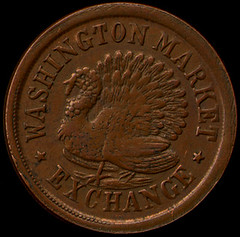 NY630CC-4A.........R2 MS63
NY630CC-4A.........R2 MS63
MERCHANT TOKEN
OBV.1863 WASHINGTON MARKET
EXCHANGE.
REV....VEGATABLES/LIVE AND
LET LIVE.22mm.
EX. RUSS RULAU COLLECTION
To read the earlier E-Sylum article, see: STILL MORE TURKEYS IN NUMISMATICS (www.coinbooks.org/esylum_v16n53a19.html)
Heavyweight Numismatic Books Fred Michaelson writes:
I see that John and Nancy Wilson called the Fred Reed book a "heavyweight champion" at four pounds. I wonder what they'd call QDB's "A California Gold Rush History" (eleven pounds). I really enjoyed their review. Looks like a great book.
To read the earlier E-Sylum article, see: BOOK REVIEW: CIVIL WAR STAMP ENVELOPES (www.coinbooks.org/esylum_v16n53a05.html)
Mark Schlepphorst Contact Address Bob Fritsch writes:
Mark Schlepphorst gave me his new email address for distribution to the group: mschlepphorst@verizon.net. He is also working on the upgraded website for Signature Art Medals, his company with Dick Johnson.
Happy New Year to you. I look forward to another 52 great issues of The E-Sylum.
Chinese Copycat Dusty Royer writes:
I thought your readers might find this information interesting and goes hand in hand with Howard Daniel's comments on counterfeit polymer notes.
A friend of mine sold a Central Bank of Manchukuo 1yuan (P-SJ125) from 1932, on eBay. It was purchased by a "collector" in China. When he received the note, he sent my friend an email praising the condition of the note (Uncirculated) and then ask what he would buy it back for as he only needed it to make copies! As always, let the buyer beware!
To read the earlier E-Sylum article, see: HOWARD DANIEL ON POLYMER BANKNOTES (www.coinbooks.org/esylum_v16n53a23.html)
Phone Number Correction: Pennsylvania 6-5000 Pete Smith writes:
This week there was a reference to Pennsylvania 6-500. I believe this is from the lyrics to a song by Glen Miler. This is often confused with Pennsylvania 6-5000 recorded by Glenn Miller.
To read the earlier E-Sylum article, see: THE EARLIEST COIN DEALER PHONE NUMBER? (www.coinbooks.org/esylum_v16n53a14.html)
Ginger Rapsus on the Churchill Crown Ginger Rapsus writes:
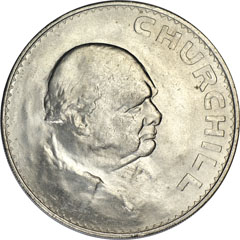 Many thanks for the December 29th E-Sylum. That was a very informative issue, with lots of good stuff! I'm glad someone wrote of the Churchill Crown. I think it was the first world coin I bought. It was simple & inexpensive, so everyone could have one. Folks who just wanted a souvenir didn't care about fancy designs--they just wanted to see Churchill's portrait.
Many thanks for the December 29th E-Sylum. That was a very informative issue, with lots of good stuff! I'm glad someone wrote of the Churchill Crown. I think it was the first world coin I bought. It was simple & inexpensive, so everyone could have one. Folks who just wanted a souvenir didn't care about fancy designs--they just wanted to see Churchill's portrait.
I also liked the bit about dinner by Johnny Unitas' mother. How about dinner with Drew Brees?
To read the earlier E-Sylum articles, see:
THE 1965 CHURCHILL CROWN
(www.coinbooks.org/esylum_v16n53a12.html)
NOTES FROM E-SYLUM READERS: DECEMBER 29, 2013 : Howard Gibbs and Football Player Johnny Unitas
(www.coinbooks.org/esylum_v16n53a09.html)
The Saint Nicholas National Bank of New York Regarding "Saint Nick" currency, Peter Huntoon writes:
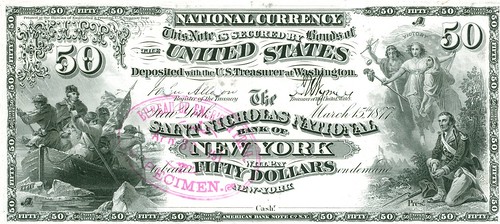
To read the earlier E-Sylum article, see: QUERY: SANTA CLAUS ON A LARGE DENOMINATION U.S. BILL (www.coinbooks.org/esylum_v16n53a21.html)
Another New Year's Postcard L. D. Mitchell forwarded this. Thanks!

To read the earlier E-Sylum article, see: POSTCARDS AND NUMISMATICS: HAPPY NEW YEAR! (www.coinbooks.org/esylum_v16n53a26.html)
STILL MORE ON THE SERIAL COMMA
Serge Pelletier writes:
As a translator, I can tell you that I highly favour the serial comma because it takes away any ambiguity there might be.
Fred Schwan writes:
Regarding the "Oxford comma", since we're talking about the Oxford Numismatic Society's list - rules are good but sometimes they need to be handled flexibly when the sense demands it, or when sticking too firmly to them might result in ambiguity. The examples you quote cover the ground nicely...
One of my personal grammar issues is the placement of minor punctuation (meaning periods and commas) and quotation marks. In American use the minor punctuation always goes inside the quotation marks. British use, in order for the punctuation to be inside the quotation marks, the punctuation has to be part of the quote. This is a logical approach but it creates the unsightly ""Oxford comma"," situation. By the way, I am entirely uncertain about the use of quotation marks in that last sentence. Anyway, to me the humor to me was the incorrect American use not only in a discussion of punctuation use, but also in a phrase with the word Oxford!
Thanks for your great service and Happy New Year to you and the entire E-Sylum staff!
Anyone who was listening back then knows that use of the last serial comma is correct, because there is the same pause after B as there is after A. (in the example of A, B, and C) This obviates the need for books, complicated rules and PhD's. (I don't mean to insult any complicated PhD's.)
Paul Cunningham writes:
I see another grammatical example in this issue – Is it “1930s” or “1930’s? “ Even the grammarians may be reaching for their manuals to check that sentence!
To read the earlier E-Sylum article, see: MORE ON USING THE SERIAL COMMA (www.coinbooks.org/esylum_v16n53a13.html)
STEVE D'IPPOLITO ON NOVODELS AND FANTASY PIECES
Last week, John Dannreuther wrote:
The Confederate cents may be fantasies, but the 1804 dollar should not be called such, in my opinion. They were struck by the US Mint in 1834, just dated 1804. You can call them novodels or whatever, but they are not fantasies, as I understand the term.
The 1913 nickel issue is a fantasy, I guess, but I call that one a clandestine issue, as it was from Mint dies, just struck in secrecy, like the 1884 and 1885 Trade dollars (thank you, A. Loudon Snowden for these two Trade dollars and for not melting the two Half Unions!).
This time, I'll agree with John Dannreuther. It's important when throwing terms about like "fantasy piece" around to be careful the entire definition applies. The 1804 dollar is indeed a novodel, and the 1913 nickel is best described as clandestine (I can't think of another parallel case off the top of my head)
The term novodel comes out of Russian numismatics, novo (ново)=new and del' (дель)=made or done, roughly), because the Imperial Mint made lots and lots of them over the decades. Some people collect them avidly, enough to drive the prices above originals, and others (like me) avoided them.
Russian numismatists will even make distinctions between different classes of novodels. For example: 1) dates that originally did exist off of dies very close to the originals (there may be a die variety difference which clues the knowledgeable person into the fact that this particular piece is a novodel even though it looks to the casual glance "just like" the other pieces of that denomination and date--early 19th century small silver is like this--buy a copy of R. W. Julian's book and check the crown on the reverse), 2) coins obviously different from the original (such as being struck in collar when the original wasn't, and on an obviously not-all-that-faithfully recreated die, or with much better workmanship), and then 3) there are novodels of dates and denominations that didn't originally exist (such as silver Siberian pieces), those sometimes are called fantasy novodels, but the key word is novodel, not fantasy. It's a novodel if it was a sanctioned mint strike after the fact. There are more possible classes. Don't take my numbering of classes as meaningful, my references have different and longer lists in them--there isn't an "official" list of kinds of novodels that I know of.
(Incidentally, just continuing to use dies into the next year because they were too expensive to just throw away, doesn't count as a novodel. Otherwise some 1803 dollars, actually minted in 1804 and leading to reported mintages of dollars in 1804, would be novodels. Ironically, those would be the very dollars that caused the whole mess in the first place, since their appearance in mint records caused collectors to seek 1804-dated dollars and created the demand for them that, ultimately, the mint "helpfully" filled with a novodel.)
The 1804 dollar clearly qualifies as a novodel since it is a mint product produced after the date on the coin for the benefit of collectors, and we know it as such from the shape of the denticles if nothing else. In a way it should fall under the third group in my list of examples above, because there were no original 1804 dollars. On the other hand, at the time people probably thought that there were original 1804 dollars because they were relying on the mintage numbers, so as far as intent goes it falls into one of the other groups. And it wasn't totally ridiculous like many "fantasy novodels" are. Whether you regard the denticles as a subtle enough difference to lump it into the first or second group I named above, is a judgment call.
Incidentally, the Russians pronounce it "nuh-vah-DYEL." Which I suspect most Americans wouldn't recognize because of palatalization and the vowel shifts in unstressed syllables, so I'll typically Americanize it to "NO-vo-del" or might half-heartedly try to keep the word's Russian roots and say "no vo DEL."
To read the earlier E-Sylum article, see: MORE THOUGHTS ON FANTASY COINS (www.coinbooks.org/esylum_v16n53a11.html)

THOMAS SULLY'S INFLUENCE ON U.S. COINS AND CURRENCY
Those interested in the artists behind the designs on U.S. coins and currency may like to know about a special exhibit curated by the Milwaukee Art Museum, Thomas Sully: Painted Performance. As described by the museum, "the exhibition is the first retrospective of the artist in thirty years, and the first to explore the artist's entire career in depth." Yesterday, my wife and I took the opportunity to view the exhibit.
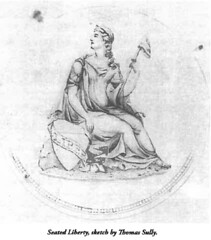 When the exhibit was announced, I reviewed Taxay's U.S. Mint and Coinage and Vermeule's Numismatic Art in America for their coverage of the evolution of the Seated Liberty or "Gobrecht" coinage. I had forgotten about Clain-Stefanelli's excellent article in the ANA Centennial Anthology - thank you to Edward Carmody and The E-Sylum for bringing back to my attention that work.
When the exhibit was announced, I reviewed Taxay's U.S. Mint and Coinage and Vermeule's Numismatic Art in America for their coverage of the evolution of the Seated Liberty or "Gobrecht" coinage. I had forgotten about Clain-Stefanelli's excellent article in the ANA Centennial Anthology - thank you to Edward Carmody and The E-Sylum for bringing back to my attention that work.
While the concept of a seated Liberty for the coinage clearly belongs to Mint Director Patterson, the design executed by Gobrecht clearly owes its greatest debt to Sully's drawing but also includes elements, especially the position of the arm and the shield, from Titian Peale's. (The Milwaukee exhibit includes an excellent portrait of Titian's father, Charles Willson Peale by Sully).
The exhibition of course makes no mention of Sully's involvement with the coinage, dealing as it does with Sully's painted works, and the coinage drawing would have been a minor sidelight to his career. It does, however, include one of Sully's portraits of Andrew Jackson that later became the source for the engraving on the 20-dollar bill.

As to Mr. Carmody's assertion that the seated Liberty design was "was largely determined by President Andrew Jackson", I would await documentary evidence. Teddy Roosevelt notwithstanding, I think to most presidential office-holders the minutiae of coinage design would be of passing interest.
So should we really call this series "Gobrecht" coinage? His name is a convenient moniker as his work was the common denominator translating the images of Sully, Peale, (and later, I presume, Robert Ball Hughes' version of seated Liberty) into coinage dies. The inspiration however belongs elsewhere.
What about the removal of Gobrecht's name from the base of Liberty? Is it possible Sully objected to Gobrecht taking credit for the work? The Milwaukee exhibit demonstrates Sully's keen awareness of the art market of the time. Sully created sample paintings as "marketing tools", and these always include Sully's initials TS and the date.
Clain-Stefanelli illustrates and comments on a rather mysterious painting that reproduces the seated Liberty of Gobrecht's final design, but with Sully's initials TS and the date 1836. A subtle claim to authorship? Questions probably forever unanswerable.
I'm sorry this note is so late: the exhibition in Milwaukee runs only through January 5, 2014, but then travels to the San Antonio Museum of Art, February 7-May 11, 2014.
For more information on the Sully exhinit, see: Thomas Sully: Painted Performance (mam.org/thomas-sully/)
To read the earlier E-Sylum article, see: ROBERT M. PATTERSON AND THE SEATED LIBERTY DESIGN (www.coinbooks.org/esylum_v16n51a18.html)
ADVENTURES IN PUBLISHING COIN BOOKS
Adventures in Publishing Coin Books
By Mike Shutty Jr
I enjoyed reading about the experiences described last fall (E-Sylum v16n37) about Paul Torongo’s foray into numismatic self-publishing using Amazon’s Create Space. I would like to add my experiences to the dialogue. From the start, let me say that I am in the writing business to have fun and extend my collecting experiences. That said, it is nice to have readers and to sell a few books along the way.
In the past three years I have written two coin books. The first book was entitled One Coin is Never Enough and was published by Krause in October 2011. The second book was entitled Communion Tokens: A Guide for Collecting Scottish, Canadian & United States Tokens and was self-published through Wasteland Press in July 2013. Consequently, I can compare the two experiences. Keep in mind that I am virtually unknown, so unlike David Bowers or the many other popular writers, there is no pre-publication anticipation or excitement for my books.
 I originally sent a copy of One Coin is Never Enough to Whitman in March 2009 and after nine months was told that the book read too much like a dissertation. I re-wrote it in a friendly tone that I had honed by writing a couple of articles for The Numismatist. The following March, I called Debbie Bradley at Krause, and she graciously listened to my pitch and asked me to send a few chapters and a book proposal. The book was accepted in July of 2010. Working with Krause was a wonderful experience, and Debbie was very upbeat about the project. I had to add about six chapters to broaden the appeal, so I spend all winter writing and taking photos. Once I was done, the waiting period began. The book was edited, and it hit the market in the Fall of 2011.
I originally sent a copy of One Coin is Never Enough to Whitman in March 2009 and after nine months was told that the book read too much like a dissertation. I re-wrote it in a friendly tone that I had honed by writing a couple of articles for The Numismatist. The following March, I called Debbie Bradley at Krause, and she graciously listened to my pitch and asked me to send a few chapters and a book proposal. The book was accepted in July of 2010. Working with Krause was a wonderful experience, and Debbie was very upbeat about the project. I had to add about six chapters to broaden the appeal, so I spend all winter writing and taking photos. Once I was done, the waiting period began. The book was edited, and it hit the market in the Fall of 2011.
Unfortunately the book did not sell very well. I was crushed, as I had worked on it for years. I submit that it is the best psychological study of coin collectors available. The book was recognized for an Extraordinary Merit award from the Numismatic Literary Guild in August 2012, but by that time the book was poised to go into “remainder status.” This is when all the books are marked down to fire-sale prices. As for me, I kept my $3000 advance and purchased a new computer to write the next book. I know that everyone at Krause wanted the book to succeed, so I feel bad that we did not succeed together. All told, only about 700 books sold – but it is still for sale in a number of venues.
I learned a few lessons from this experience that led me to self-publish the next one. First, I learned what all seasoned writers know: you have to promote your book. Books do not sell without some sort of push. Second, the wait is very long from submitted manuscript to actual release. Third, the new writer has limited control over the book if you sign-on with a big publisher. Now this was not a problem with Krause, as they were easy to work with and shared my vision – the added chapters were a good idea and the design was great. Fourth, mainstream books sell at high volume, whereas niche books will appeal to few. To be frank, most collectors are busy collecting, so price guides and catalogs are the books that sell. Introspective books about collectors are not big sellers.
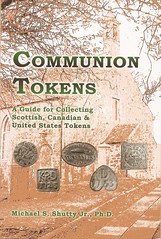 Since I had been collecting communion tokens and could not find a guidebook, I decided to write a short one to test out the idea of self-publishing. Communion tokens are not that popular, so I knew that there would be few readers if I decided to pursue this idea. On the plus side, it is a guidebook, and collectors like this kind of book. Besides, I could not help myself, I like the tokens too much not to write something about them!
Since I had been collecting communion tokens and could not find a guidebook, I decided to write a short one to test out the idea of self-publishing. Communion tokens are not that popular, so I knew that there would be few readers if I decided to pursue this idea. On the plus side, it is a guidebook, and collectors like this kind of book. Besides, I could not help myself, I like the tokens too much not to write something about them!
I perused many self-publishing websites, requested nifty publishing guides, and talked to aggressive sales reps. But most helpful was Mark Lavine’s book entitled, The Fine Print of Self-Publishing (4th Edition), published in 2011. This book reviewed most of the publishers vying for your dollars and dreams. He provided a detailed accounting of royalties and other costs, plus reviewed each publishing contract. Peter Bowerman’s book, The Well-Fed Self-Publisher was also helpful for its broad sweep and in outlining the challenges of going it alone.
I chose the print-on-demand (POD) route and decided to go with Wasteland Press. Wasteland Press had one big advantage over other companies – namely, black & white photographs of any number were free of charge. This is important for coin books. They offered several packages but all of them include book cover design, ISBN, and exposure through Amazon and other online retailers. Plus, they have their own bookselling website (Books123.org).
I decided to take the time to format my book completely in MS Word; as such, I set the margins for the 6x9 page size, inserted all photos in TIF format, and added captions using text boxes. I took all the photos and used Photoshop to adjust the lighting and size before inserting into the manuscript. Of course, one of the fun aspects of all this was that I was purchasing tokens for the book during the whole process – collecting takes on a whole new slant when you need one for the book. I designed the cover using a public domain photo of a Scottish church, adding type, and superimposing my favorite tokens along the bottom. It was a great experience to do it all!
After sending the manuscript and cover design to Wasteland Press, they had an electronic proof for me to review in less than two weeks. The instructions were to list your corrections and send it back. A day later, a new proof was sent. I made more changes. This process continued several times until I was discovered reciting certain paragraphs from the book in my sleep. I got sample book a week later! Two weeks later, a box of 75 books arrived on my doorstep.
I developed the following marketing plan. I started a blog, entitled Collecting Communion Tokens, and I sent copies to family, collecting friends and a few dealers that I particularly enjoyed buying from. I took out an ad in the TAMS Journal for three issues at $85; I also put a short promo in the free classified section. I purchased 100 book boxes from ULINE at $0.60 each. I crafted an Author’s Page on Amazon and promoted the book on my blog. Wayne Homren graciously announced the publication of the book in The E-Sylum. Finally, I put the book up on eBay for a Buy It Now price of $12.
So how is business? Slow is the answer. But of course, I am writing about communion tokens, not large cents or silver dollars. In the first quarter, I sold 26 at Books123.org and 12 more privately. My first quarter (July through September) royalty check was $63, plus about $130 for the private sales. I have $1005 total costs. Twelve books were given as gifts, including one to the ANA library. I do not have the second quarter earnings yet, but I sold about 20 privately this time around. All told, I plan to keep my day job as a psychologist.
I have left out the best part, and it is this: I have met many folks through the blog such that the world of communion tokens has opened up from a relatively lonely pursuit to an socially active one. In fact, the blog has taken on a life of its own and has satisfied my urge to write. At 80+ postings and about 800 hits per month, it is becoming a meeting place. In closing, let me say that writing a book – even if it is just about your own collection – is great fun! I am currently working on a more in-depth analysis of communion tokens despite the lack of a market for such a book.
To read the earlier E-Sylum articles, see:
AN AUTHOR'S EXPERIENCE: CREATESPACE AND AMAZON.COM
(www.coinbooks.org/esylum_v16n37a10.html)
To read the earlier E-Sylum articles, see:
NEW BOOK: ONE COIN IS NEVER ENOUGH
(www.coinbooks.org/esylum_v14n40a04.html)
To read the earlier E-Sylum articles, see:
NEW BOOK: COMMUNION TOKENS
(www.coinbooks.org/esylum_v16n29a03.html)
THE 1763 CHARLESTOWN SOCIAL CLUB MEDAL


1763 Charlestown Social Club, XF-AU
Betts-508, Bronze
One of Only Three Known, Sole Collectible Example
Betts-508. 1763 Charlestown Social Club. Bronze. XF-AU. 33.5 x 36.0 mm, 16.5 gm. Unsigned. One of only three examples known, this is one of only two available to collectors as the third example resides at the Massachusetts Historical Society.
This oval piece features two men in eighteenth century dress shaking hands at center. They are standing outdoors with a tree to the left and a church and other buildings in the background at right. The legend translates as, "Bound in friendship." Text covers the back in six lines and reads, "SOCIAL CLUB INSTITUTED CHARLES TOWN SOUTH CAROLINA VI OCTOBER MDCCLXIII."
Despite extensive research over the course of decades, no information concerning the club has been unearthed. As John Kraljevich wrote in Coin World in September 2011, "As early as 1856, Boston numismatist Jeremiah Colburn, wrote to antiquarians in Charleston trying to figure out which club produced the medals, and he even managed to find the last surviving member of a group called the Charles Town Social Club. No one knew a thing about the medals. The trail has only gotten colder since."
A beautifully preserved example, this piece features attractive chocolate-brown color overall, with gorgeous mint color and luster present at many of the protected areas. The few marks present are minuscule. A small die break appears on the reverse to the right of MDCCLXIII.
Ex: Glendining (12/1922), lot 77; John J. Ford, Jr. (10/1972); Lucien M. LaRiviere Collection, Part II (Bowers and Merena, 3/2001), lot 2107; Purchased from Ted Craige.
From The John W. Adams Collection.
To read the complete lot description, see: Lot 3068. Betts-508. 1763 Charlestown Social Club. Bronze. (coins.ha.com/c/item.zx?saleNo=1201&lotNo=3068)
THE SYDNEY MINT MEDALLION OF 1901
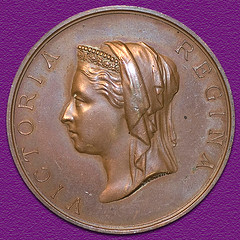
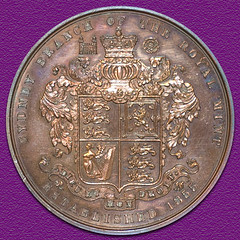
This enigmatic medallion is the first in a unique set of three – they are the only medallions struck by an Australian Mint prior to 1931 that commemorates the Mint, as opposed to an event or occasion.
Although the Sydney, Melbourne and Perth Mints each struck a small number of medallions commemorating a range of important events, only these three Sydney Mint medallions relate to the Mints themselves.
According to research published by John Sharples, Numismatic Curator at the Museum of Victoria, this medal was “…issued in 1901 to publicize the Sydney Branch of the Royal Mint.”
We can imagine that the selection process for the designs to be used on a medallion intended to advertise the design expertise and production quality of the Sydney Mint would have been very carefully thought through. Consideration of the design elements either side bear this conclusion out.
The basis for the reverse design on this medallion was first seen on the British 1825 proof crown of King George IV. In what is regarded as a standard work on the subject of British silver coins (The Silver Coins of England), the British numismatist Edward Hawkins offered the following comment about this design: “This reverse is beautifully executed by Merlen… These pieces are exceedingly beautiful, but, though dies were prepared also in 1828 and 1829, none were actually issued for currency.”
Several minor additions were made to Merlen’s original design for the reverse of this medallion – a small depiction of the Tower Mint at London can be seen to the left of the crown at the top, while a rose can be seen to the right of the crown.
The inclusion of an image of the Tower Mint was a clear signal that the medallion was an official product of a branch of the Royal Mint, articulating all of the expectations of quality and expertise that history might bring.
The two subsequent medallions issued in this series feature the same reverse design, however feature the portraits of King Edward VII and King George V respectively. Further research will undoubtedly inform us as to the reasons for which these rare, impressive and attractive medallions were struck.
Just what we should make of the fact that only one type of medallion was struck during the reign of each monarch remains to be seen. One such medallion, struck in silver and featuring the portrait of King George V, was offered for sale by Noble Numismatics as part of the John Chapman collection in July 2008. This medallion was described as “inscribed around edge ‘A.M. Le Souef’.” Albert Malet Le Souef was the last Deputy Master stationed at the Sydney Mint – his association with this medallion indicates that while the Sydney Mint medallion with the portrait of Victoria may well have been struck to act as an advertising medium, if that is the case they were clearly an exclusive advertising medium, one also presented to important dignitaries involved with the history of the Sydney Mint.
Further research is sure to shed more light on the rarity and purpose of these enigmatic medallions.
To read the complete article, see: The Sydney Mint Medallion of 1901 (blog.perthmint.com.au/2014/01/02/the-sydney-mint-medallion-of-1901/)
To read the original article, see: The Sydney Mint Medallion of 1901 (www.sterlingcurrency.com.au/research/sydney-mint-medallion-1901)
THE BOOK BAZARRE
ROBERT HEATH'S NEW ENGLAND MEDAL CATALOGS
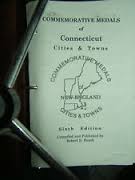 While reading an inquiry on Jeff Shevlin’s blog at So-Called Dollar Discussion Forum a correspondent mentioned he had acquired one of Bob Heath’s books on the medals of one of the six New England states. Since this relates to some scarce numismatic literature I’ll comment in The E-Sylum as well as on Jeff’s blog.
While reading an inquiry on Jeff Shevlin’s blog at So-Called Dollar Discussion Forum a correspondent mentioned he had acquired one of Bob Heath’s books on the medals of one of the six New England states. Since this relates to some scarce numismatic literature I’ll comment in The E-Sylum as well as on Jeff’s blog.
Robert Raymond Heath (1934-2005) -- he probably was not related to ANA’s founder Dr George Heath – but Bob Heath is considered the founder and chronicler of the commemorative medals issued by New England towns and cities. He had fun gathering these medals and cataloging them. I sold him a few of these when I was a medal dealer. We chatted often.
He gathered what facts he could: metal varieties, edge looped or plain, issue price, and assigned a catalog number; he then described both sides and added what other facts he could find -- who designed them, who struck -- the obscure datum of each medal. The accumulation of this info forms the collector lore we all like to learn about specimens in our collections.
Beginning in 1977 he published a list of Commemorative Medals of Massachusetts Cities and Towns. Massachusetts was his home state, an obvious first to publish. Other states followed. When he acquired enough new specimens he published a new “edition” using existing pages.
He typed up his data and placed this with an illustration of the medal, one medal per page. His pages were all 8½ x 5½ -- half the size of normal paper – he could get two pages to each photocopied sheet. He liked the loose-leaf format. He didn’t number the pages, but placed the date he compiled or revised the info at the bottom of each page. This way he could update any new data or insert a new page with fresh data for any newly acquired specimen at any time.
His numbering system was particularly ingenious. He gave a serial number – one up -- for all town and city names in a state arranged alphabetically. Then a chronological number for each medal in that town or city. Boston, for example is MA 035 with 39 medals listed.
I acquired a complete set of all six states listings before he died. Here are the six:
- Connecticut -- four editions to 1996 – 175 medals.
- Maine -- three editions to 1994 – 174 medals.
- Massachusetts -- seven editions to 1995 – 626 medals.
- New Hampshire -- five editions to 1997. – 218 medals.
- Rhode Island --. four editions to 1997 -- 42 medals.
- Vermont -- four editions to 1997 – 45 medals.
Total all editions – 1,280 medals.
In a subsequent conversation I asked Bob why didn’t he gather all this in one listing of all New England states and print this in one book or pamphlet. That would take away all the fun, he said.
He started selling parts of his collection before he died, but afterwards continuing the task of revising state lists was assigned to four fellow collectors. I related this in an E-Sylum item (Volume 9, Number 13, Article 3) where I listed the names of the four collectors. However, I have not learned of any such revised editions being published.
Perhaps that is just as well. Illinois numismatist Sheldon Banoff has been collecting all American city AND state medals for nearly five decades. He cannot tell me the total number he has -- or is aware of -- but it is probably more than five thousand. Now, THAT’S THE CATALOG I want to acquire!
To visit the So-Called Dollar Discussion Forum, see: so-calleddollar.com/Forum/
To read the earlier E-Sylum article, see: BOB HEATH'S MEDAL CATALOGS TO CONTINUE (www.coinbooks.org/esylum_v09n13a03.html)
THE DEERFIELD, MONTANA HORSE CAR TOKEN
I read with great pleasure the article on horse car transportation tokens in The Numismatist last month. I am very familiar with transportation tokens and especially the horse cars.
Robert Rhue, the writer of the article, is a fine person, easy to deal with and sharp as a tack! But, as horse car tokens go, he “left something on the table.” There is a horse car token that he does not have and, unfortunately for him and the hobby, cannot have.
Some background: There exists a horse car token from Deerfield, Montana. The token is probably unique as a second has never been offered for sale anywhere, to my knowledge. It was described in the seventh edition of Atwood’s Catalogue of Transportation Tokens of the U.S. and Canada (and the Fourth Edition, Volume Two, History and Encyclopedia of the same) as being inscribed A. MYERS DEERFIELD, MONT. with a picture of a deer head on the obverse and a picture of a horse car on the reverse.
The early catalogers had A. Myers as the postmaster of Deerfield, MT, in 1887, and having a general store there. The catalogers further note that Myers was the only person having any business in that town. What about the town? Modern internet searches do not mention a Deerfield, MT, but only Deerfield Colony, a “colony” of the Hutterites and a school.
The old Deerfield had a post office from 1888 to 1919, which fits into the A. Myers time frame; it is assumed that Deerfield Colony is all of what is left of the old Deerfield, located some 120 miles east of Great Falls.
The transit enthusiasts have hung a “pattern” or “muling” explanation on the token. Some think that the Meyer and Wenthe Company in Chicago muled the reverse die, which is the same as IA590B, with an A. Myers storecard. This sounds like a real possibility except that in more than 100 years no collector has reported the existence of any A. Myers card, let alone any Deerfield trade token!
Some say that it is probably a pattern, meaning that sometime in the murky past Myers requested an example of a storecard from Meyer and Wenthe. This could make sense to Myers, if he thought that this little town might make a name for itself and need public transportation; however, the records show that this location became no more than a ghost town.
What about the token? In 1975 I bought a large collection from Norman Sherman, a well-known and well-heeled collector from Southern California. The collection had all the known-at-the-time horse car tokens, including the Deerfield piece. I put the horse car collection up for sale immediately, at a California token and medal show. It was priced at $4000 and for three days, it attracted no takers. It was then broken up.
A short time after that I sold the Deerfield token to distant relatives of A. Meyers. All that is left for me are memories of the collection and a picture! We can assume that the token will be off the market for a long period of time
KANKAKEE AND LYDIA, THE TATTOOED LADY
David Menchell writes:
I guess it just shows you where my mind is at, but when I saw your question about Kankakee, I immediately thought of Groucho singing "Lydia, the Tattooed Lady": "For a dime you can see Kankakee or Paree or Washington crossing the Delaware".
Dan Demeo writes:
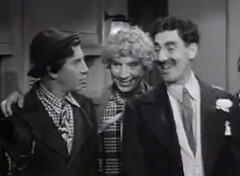 I'm surprised that you didn't get any answers related to the "other" song referencing Kankakee, that being 'Lydia the Tattooed Lady.' Lydia, sung by Groucho Marx in the 1939 movie, "At the Circus," was written by Harold Arlen, and words by E.Y. "Yip" Harburg. Groucho, or Capt. Spaulding, as he enumerates her tattoos, sings "...you can see Kankakee or Paree...", rhyming the Illinois city with both see and Paree, the French capital.
I'm surprised that you didn't get any answers related to the "other" song referencing Kankakee, that being 'Lydia the Tattooed Lady.' Lydia, sung by Groucho Marx in the 1939 movie, "At the Circus," was written by Harold Arlen, and words by E.Y. "Yip" Harburg. Groucho, or Capt. Spaulding, as he enumerates her tattoos, sings "...you can see Kankakee or Paree...", rhyming the Illinois city with both see and Paree, the French capital.
Anyway, "At the Circus" is well remembered by some of us, and will be celebrating the 75th anniversary of its release in 2014. I guess it was a bit overshadowed at the time, because "Gone With the Wind", was also released in 1939, and it had both color and Clark Gable not giving "a damn", but I don't remember him singing anything.
To read the complete lyrics, see: Lydia, The Tattooed Lady - Groucho Marx (dmdb.org/lyrics/lydia.html)
To watch Groucho singing it on YouTube see: Lydia the Tattooed Lady (www.youtube.com/watch?v=n4zRe_wvJw8)
On New Year's Eve John Dannreuther wrote:
The City of New Orleans just passed my condo. 10:46... A minute late!
I responded:
The song could have just as easily been named "The Disappearing Railroad Blues." But I like "City of New Orleans" better. I've only been to Nawlin's twice, but had a great time. Maybe I should take the train. I'll wave to you (or moon you), depending on how many times we pass the bottle beforehand...
To read the earlier E-Sylum article, see: QUIZ ANSWER: CITY OF NEW ORLEANS (www.coinbooks.org/esylum_v16n53a08.html)
THE 1954 “DEVIL’S FACE” CANADIAN BANKNOTES
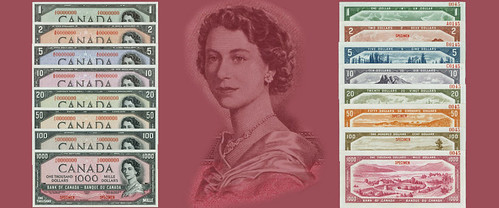
We are pleased to present one of the most important Canadian Banknote offerings we have handled, and a set that is likely missing from even advanced collections. This short-lived 1954 "Devil's Face" series displays the portrait vignette of Queen Elizabeth II at right with a hair styling that creates an easily discernible and sinister face. This engraving error quickly became controversial after its release and new plates were prepared. The series is always heavily collected, and the higher denominations are quite scarce in Uncirculated grades. These specimens are seldom available, save for the more available $5 and $10 denominations. With only seven $1,000 specimens of this Devil’s Face type known, only that many sets can be compiled.
To read the Stack's blog article, see:
Rare “Devil’s Face” 1954 Specimen Set Part of Upcoming January NYINC World Banknote Auction
(www.stacksbowers.com/NewsMedia/Blogs/TabId/780/ArtMID
/2678/ArticleID/64286/Rare-%E2%80%9CDevil%E2%80%99s
-Face%E2%80%9D-1954-Specimen-Set-Part-of-Upcoming-January-NYINC-World-Banknote-Auction.aspx)
In 1952 the Bank of Canada commissioned George Gundersen, of the British American Bank Note Company, to design the forthcoming issue of bank notes, scheduled for 1954. In executing the design, Mr. Gundersen based his engraving of Queen Elisabeth II on a portrait photo taken by Peter-Dirk Uys, one of Her Majesty's official photographers. Everything unfolded as it should have, following all of the normal procedures. The bills were printed and put in circulation. Then, in 1954, a citizen's complaint alarmed the Bank of Canada; the outline of a devil‚s face was visible in the Queen's hair, right behind her ear.
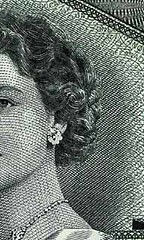
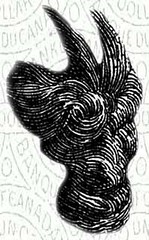
Heavens! Mr. Gundersen, the engraver, was the first suspect. He denied the accusations, claiming he had worked from the photograph issued to him. But someone had to be guilty of the crime. Some hypotheses suggested the work of a prankster employed at the Bank of Canada. French-Canadian nationalists or IRA sympathizers were also suspected. Time went by and the scandal faded for lack of proof, as the original photographic negative could not be found.
What is now called the Devil‚s Face could equally have been an involuntary act. Just a bad hair day! But in the end, Mr. Gundersen would modify the portrait of the Queen by shadowing out the Little Devil; new bills would be printed and put in circulation. The Devil's Face bills would be pulled by the Banks, stamped CANCELLED on the front and marked with the seal of the institution that cancelled it on the back.
It was only in 1984 that the scandal re-erupted with the death of the photographer and the recovery of the negatives from the 1952 photo shoot, events which coincided with the publication of Peter-Dirk Uys‚ memoirs (Uys, Peter-Dirk, Her Majesty's Image - The Life Of The Official Photographer Of Elisabeth The Second, Yellow Sheets Books, London (UK), 1985).
In his account, Mister Uys writes openly of his homosexuality and his long relationship with John Rietveld, Her Majesty‚s hairdresser from 1947 to 1962. Even more surprising is the revelation that Uys flirted with certain circles of initiates before holding his job at Buckingham Palace. We learn in the book that he was one of Aleister Crowley's (an eccentric, writer and devil-worshiper) disciples, as well as Kenneth Anger's (a photographer and filmmaker) lover during the 1940's, just before his final dedication to the trade of portrait photographer.
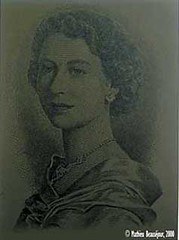
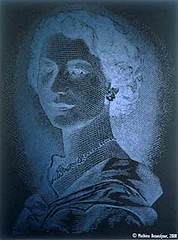
To read the complete article, see: DEVIL'S FACE (www.agencetopo.qc.ca/devilface/eng.html)
To read the earlier E-Sylum article, see: OPTICAL ILLUSIONS ON COINS AND MEDALS (www.coinbooks.org/esylum_v16n53a16.html)
EMPLOYMENT OPPORTUNITY!
Live and Work in Southern CaliforniaStack’s Bowers Galleries offers an important employment opportunity for the right person. We are seeking an experienced numismatist in the American series—coins, tokens, medals, and paper money—to work with our “dream team” of catalogers, building on the tradition of the Ford, Eliasberg, Bass, Cardinal, Norweb, Battle Born and other great collections.
If you can write in an authoritative and compelling manner with a high degree of accuracy, this may be just right for you! You will be working in Irvine, a modern community in dynamic Orange County, California—one of the finest areas to live. We offer generous benefits including medical and dental coverage, 401K plan, and more. Our offices are in our own modern, state-of-the art building with all amenities.
If you would like to be considered for this position please contact Q. David Bowers by mail or by email with your resumé, samples of your past writing (on numismatics or other subjects), and salary requirements: Mail to the attention of Q. David Bowers, PO Box 1804, Wolfeboro, NH 03894. Email to: Ckarstedt@stacksbowers.com
SCHWUNDGELD: THE DEPRESSION SCRIP OF WÖRGL, AUSTRIA
Ursula writes:
Once upon a time there was a little village in Austria, which was hit hard by the Great Depression. Poverty and unemployment dominated, when the mayor developed an unconventional idea: His municipality planned to act as employer. But the employees were to be paid not in state money, but in demurrage-charged local currency. Thereby the mayor forced his employees to stop saving the money for hard times, but to spend it as fast as possible. The miracle occurred. In the middle of the crisis Wörgl witnessed boom years. Journalists and local politicians came from all over the world to learn how the village had overcome the Great Depression.
The story of Wörgl is no tale, but true. This is unfavorable, as true tales often end badly. Cause the government of Austria was not amused by the local initiative. They enforced the National Bank’s claim to be the only institution holding the right to issue legal money in Austria. Who cared that the new money had done good? It was forbidden by the highest administrative court of Austria on November 18, 1933. Once again, the State had asserted its claims at his citizens charge.
You may ask, why do I tell you this story? Well, let’s wait and see what’s going on with Bitcoins. I really wonder whether our national states will ever accept a supranational independent currency. And we are giving them the power to end this elaborate experiment within a second.
In the years after 1930 a new economic crisis afflicted the world. It did not result in inflation – quite the contrary: shocked by the hyperinflation of the German post-war era, the different states dabbled in a rigid austerity policy. The effect was that more and more people had less and less money at their disposal – they spent increasingly less money which led to a decline of demand which, in turn, resulted in layoffs depriving even more people of a regular income. It was a vicious cycle the politicians were not able to break.
At the same time, the instruments necessary to rethink were there already. In his works on Freiland and Freigeld, the theoretical economist Silvio Gesell had called for a “Natural Economic System”. Although not all of his ideas could be put into practice, the Schwundgeld nevertheless gained many supporters.
Gesell demanded money only as a means of exchange, unsuited for saving. To that purpose, he invented a currency that would not attract interest at the bank. On the contrary: to keep a note fit for circulation one had to affix a token to a fixed percentage of the total sum each month. To those unwilling to do that, only one option was left: to spend the note by the end of the month. The idea was to speed up the circulation of money with that surcharge and therewith boost the economy.
The theory was soon put into practice: supporters of the German Freigeld established the barter society WÄRA in Erfurt in 1929, with relative success: only two years later, more than 100 German companies belonged to that society. What a spectacular success when the mining engineer Max Hebecker bought a dead mine with his WÄRA loan and reopened it. An entire town received employment and an income that admittedly was based on the Wära but worked extremely well on the local scale. In 1931 however, Hebecker was forced to give up and file for bankruptcy: for fear of the right of issuing banknotes, the German finance minister had categorically denied the State Bank the production, emission and use of any emergency currency.
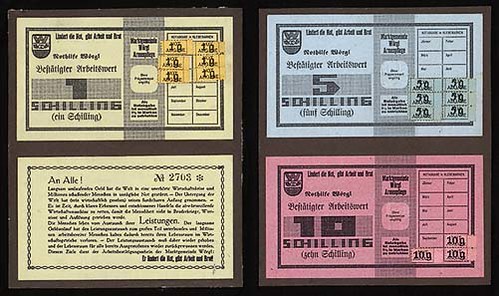
It was on July 5th, 1932, that a welfare association on a voluntary basis was brought into being: the community implemented a job creation scheme where the participants received their payments not in Austrian shillings but in labour certificates. These certificates could be bartered for goods at some shops – just like the real Austrian shillings. Other shops soon followed and in the end the new local currency became a real economy factor.
Unterguggenberger announced that those labour certificates would be accepted as a means to pay the municipal taxes as well. To encourage a rapid circulation the labour certificates were designed as Schwundgeld: each month a token at a fixed percentage of the sum had to be affixed to the note to keep it fit for circulation.
12.600 of the planned 32.000 shillings were issued as labour certificates – covered by the same sum in Austrian shillings deposited in a bank account as a pledge. And something miraculous happened: whereas an ordinary shilling achieved a turnover of 8.55 shillings per year – the community pays a worker one shilling, the worker later buys a coffee with that shilling, the cafe owner pays his sugar bill with it and so on – the labour certificates achieved 73 shillings thanks to the rapid circulation as a consequence of the depreciation.
Only 1.3 shillings per community member were circulating in Wörgl but that prompted a change of mood. Suddenly, everyone was convinced that the situation could be changed for the better. Improvements in the infrastructure like a restructuring of the station forecourt or the construction of a bridge made it visible to all that finally something was happening! The project was widely accepted. News travelled fast; even abroad the “Miracle of Wörgl” as the Berlin newspaper “12 Uhr Blatt” called it on April 18th, 1933, was on everyone’s lips.
To read the complete article, see: The Year of the Freigeld in Wörgl (www.coinsweekly.com/en/The-Year-of-the-Freigeld-in-Woergl/8?&id=17&type=a)
THE BIRTH OF THE GREENBACK
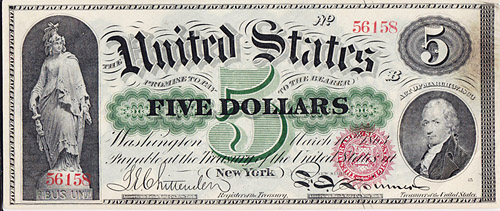
Image from the Museum of American Finance: www.moaf.org
On Dec. 30, 1861, Elbridge Gerry Spaulding, the chairman of the House Ways and Means Subcommittee on Banking and Currency, gave a speech on the House floor declaring that the nation was “never in greater peril than at this moment.” The Civil War was eight months old, but Spaulding’s concern wasn’t martial, but fiscal.
Federal expenditures to support the war effort were growing significantly; at the same time, revenues were stagnant – revenues produced by the federal income tax could not even cover the interest on the federal debt, which was rising at a vertiginous rate. To make matters worse, two days before Spaulding addressed his colleagues, the nation’s banks decided to suspend payments in gold and silver, which at the time were the only universally accepted means of payment; as a result, the federal government faced the prospect of being unable to make good on existing commitments.
It was under these dire circumstances that Spaulding introduced what he called a “war measure” and a “measure of necessity”: a bill that authorized Treasury Secretary Salmon P. Chase to issue $150,000,000 in paper notes as “lawful money and a legal tender in payment of all debts, public and private, within the United States.” These United States Notes – informally called “greenbacks,” as they were printed with green ink – were not backed by specie.
Spaulding explained that the “leading object” of the bill was “to fund the debt” and to “meet the most pressing demands upon the treasury to sustain the Army and Navy until they can make a vigorous advance upon the traitors and crush out the rebellion.” Government-issued currency was a radical proposition, he admitted. But, he concluded, “These are extraordinary times and extraordinary measures must be resorted to, in order to save our Government.”
Secretary Chase reluctantly endorsed the bill, acknowledging that the situation had become “indispensably necessary that we should resort to the issue of United States notes.” Passed by Congress and signed into law by President Lincoln, the Legal Tender Act was enacted on Feb. 25, 1862.
Today Treasury-issued notes are a ubiquitous feature of modern society.
To read the complete article, see: The Birth of the Greenback (opinionator.blogs.nytimes.com/2013/12/31/the-birth-of-the-greenback/)
AN INTERVIEW WITH AUTHOR WAYNE SAYLES
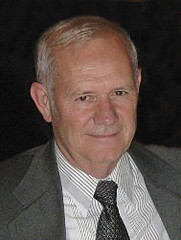 Q: Please tell us a little bit about how you developed interest in collecting coins. Was there someone or something that initially piqued your curiosity and influenced your interest?
Q: Please tell us a little bit about how you developed interest in collecting coins. Was there someone or something that initially piqued your curiosity and influenced your interest?
My interest in coins actually goes back to my very early childhood. When I was about three years old, I was watching my mother do laundry in an old wringer-type washing machine. The agitator had a bushing between the spindle and the agitator blade assembly. That bushing would wear out frequently and need to be replaced. It happened that a copper penny was just the right size and so my mother would periodically change pennies under the agitator. When she removed the old penny that day, my mother handed it to me. On the side that was not worn from friction I could clearly see the head of an Indian Chief. For a three-year-old, that was an exciting discovery. My interest in coins over nearly 70 years has always been nurtured by the thrill of discovery.
Q: After completing your degree, you published numerous literature volumes on ancient coins and even founded a journal. Please tell us a little bit about your creative process. How do you select a research topic and choose to pursue one avenue vs. another?
I have never consciously selected a research topic—they have always selected me. You used the word “passion” earlier. That is the driving force for most writing projects and it does not come through meditation or with premeditation. A writer, more often than not, is guided by the story. If one finds a particular event or phenomenon interesting, and follows that yellow brick road, the book, article or program will essentially write itself. The production of a journal is much different of course than the writing of an article within that journal. In many ways, the production of books and periodicals is an art that deals with the subliminal where writing deals with more palpable emotions. I’ve been very fortunate to experience both ends of that continuum.
Q: As a lifelong numismatist, do you have a recommendation for collectors that are just getting started? How do you build a successful collection you can be proud of.
I have often written on this very question, and my answer has remained unchanged over the years. Every meaningful collection requires focus. Choose an area of interest where success is measurable and attainable. Many beginning collectors of ancient coins attempt, for example, to collect a coin of each emperor. That may be easy to imagine, but almost impossible for most people to achieve. Conversely, focus on a single emperor can have its problems too. As an art historian, I find the subject matter of coins intriguing and have built several collections in that vein. The Spengler/Sayles collections of Turkoman figural bronze coins are a good example. Those coins appealed to me because of their iconography. They appealed to Bill Spengler because of their historical connections. By melding our interests, we were able to produce the standard reference to coins of this era as well as an innovative analysis of their meaning and purpose.
To read the complete article, see: Interview: Wayne Sayles (blog.coinsupplyplanet.com/interview-wayne-sayles/)
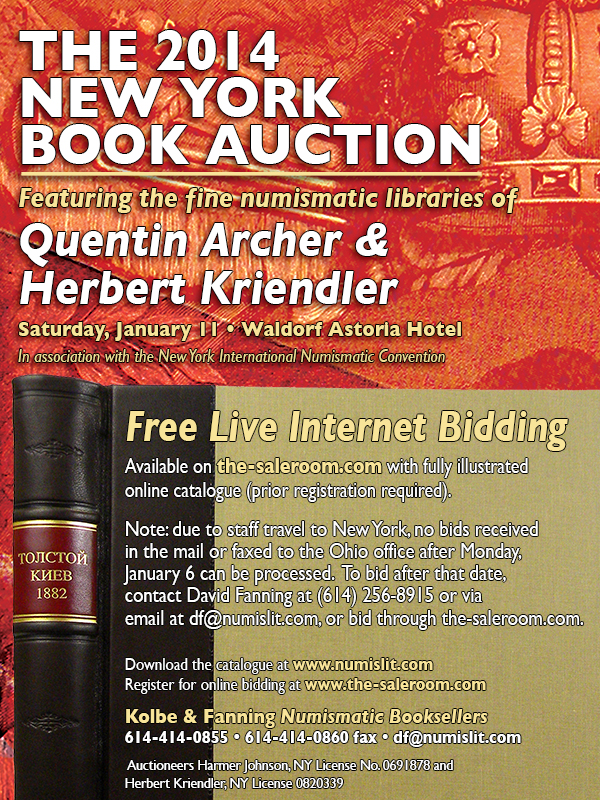
REVEALING THE LOST CODEX OF ARCHIMEDES
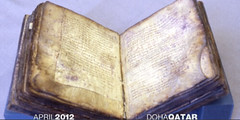 How do you read a two-thousand-year-old manuscript that has been erased, cut up, written on and painted over? With a powerful particle accelerator, of course! Ancient books curator William Noel tells the fascinating story behind the Archimedes palimpsest, a Byzantine prayer book containing previously-unknown original writings from ancient Greek mathematician Archimedes and others.
How do you read a two-thousand-year-old manuscript that has been erased, cut up, written on and painted over? With a powerful particle accelerator, of course! Ancient books curator William Noel tells the fascinating story behind the Archimedes palimpsest, a Byzantine prayer book containing previously-unknown original writings from ancient Greek mathematician Archimedes and others.
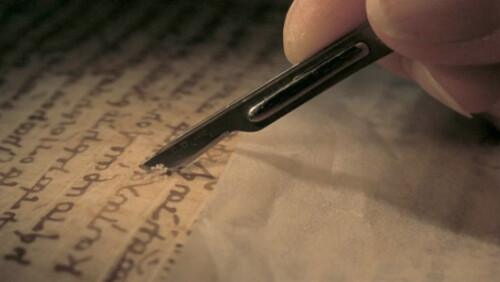
To view the video, see: William Noel: Revealing the lost codex of Archimedes (www.ted.com/talks/william_noel_revealing_the_lost_codex_of_archimedes.html)
For more information on the project, see: THE ARCHIMEDES PALIMPSEST PROJECT (www.archimedespalimpsest.org/)
THE HOBO NICKEL CARVINGS OF PAOLO CURCIO
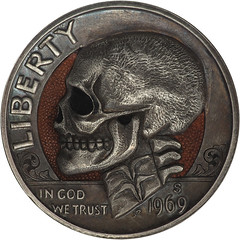 About two years we featured a great selection of skull nickels, a numismatic curiosity where miniature bas relief sculptures are carved into coins, an artform that’s broadly referred to as hobo nickel art. While researching a follow-up article on Hobonickelart.com I stumbled onto the work of Paolo Curcio (aka “mrthe”) who appears to have taken the process of carving coins to an entirely new level. Using a variety of different coins the Barcelona-based artist creates etched homages to pop culture, illustrations of figures from literature, and most commonly: macabre portraits of skulls and death, probably the most prevalent theme in hobo nickel art.
About two years we featured a great selection of skull nickels, a numismatic curiosity where miniature bas relief sculptures are carved into coins, an artform that’s broadly referred to as hobo nickel art. While researching a follow-up article on Hobonickelart.com I stumbled onto the work of Paolo Curcio (aka “mrthe”) who appears to have taken the process of carving coins to an entirely new level. Using a variety of different coins the Barcelona-based artist creates etched homages to pop culture, illustrations of figures from literature, and most commonly: macabre portraits of skulls and death, probably the most prevalent theme in hobo nickel art.
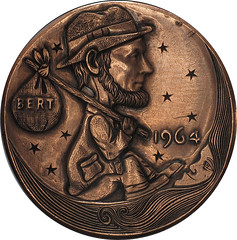

One aspect of Curcio’s process that’s really amazing is his ability to use coins made from multiple layers of metal (referred to as clad coins) which he then strategically reveals to create colored flourishes and background patterns. You can see much more of his work over on his website, and keep an eye on his Ebay page for occasional coin listings.
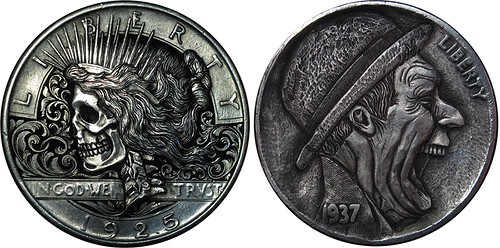
To visit Curcio’s web site, see: Remarkable Hobo Nickels Carved from Clad Coins by Paolo Curcio (www.thisiscolossal.com/2013/12/hobo-nickels-paolo-curcio/)
To read the complete article, see: www.mrthehobonickels.com/
THE DESIGN OF MODERN BRITISH COINS
The design of modern British coins
Kevin Clancy
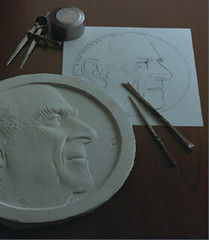 The designs on the coins we use every day
are almost certainly taken for granted –
even by those of us who have a professional interest in their
appearance. But they do change over time and from year to
year, carrying designs for subjects judged to be historically
important or of contemporary interest. You might, for
example, pull out of your pocket a two-pound coin
commemorating the 200th anniversary of the birth of
Charles Dickens and a fifty pence piece depicting a swimmer
from a series issued in connection with the London 2012
Olympic Games.
The designs on the coins we use every day
are almost certainly taken for granted –
even by those of us who have a professional interest in their
appearance. But they do change over time and from year to
year, carrying designs for subjects judged to be historically
important or of contemporary interest. You might, for
example, pull out of your pocket a two-pound coin
commemorating the 200th anniversary of the birth of
Charles Dickens and a fifty pence piece depicting a swimmer
from a series issued in connection with the London 2012
Olympic Games.
The extent to which they change is summed up neatly by Sir Christopher Frayling, a former Chairman of the Royal Mint Advisory Committee on the design of coins and medals: ‘everyone has three things in their pocket or bag: keys, mobile phones and coins. Keys have remained much the same for hundreds of years, mobile phones are redesigned every month, while coins are somewhere between the two – nearer keys than phones’.
Although only eight denominations of coins actively circulate, there are dozens of different designs but the process for obtaining and agreeing them is no less robust in every instance. The design Committee, of which Sir Christopher used to be Chairman, is now led by William Waldegrave and he is helped by lettering artists, sculptors, art historians, heralds, numismatists and representatives of the Royal Household.
For any subject a number of artists, as well as members of the Royal Mint’s Design Department, will be invited to submit ideas, usually in the form of drawings or often these days as computer-generated designs. All the work is presented anonymously to the Committee, which meets about four times a year, and members come to a judgement on a short list of designs which are then developed into low-relief sculptures.
Modern technology has made its presence felt at this stage, too, with designs increasingly being modelled on screen but for high-quality portraiture and more complex figurative compositions, traditional sculpting skills are more frequently required. A final decision is usually made at a subsequent meeting but it can take three or four sessions before a recommendation is put forward to the Chancellor and then to the Queen for approval.
While coinage design historically was the preserve of engravers, the advent of the reducing machine, whereby larger scale models of a design could be copied and reduced to coin size, opened up the field to artists from other disciplines. Over time the diversity of those approached has expanded so that today the coins in your pocket could have been designed by a painter, wood engraver, jewellery designer, silversmith, graphic designer as well as by the more traditional discipline of sculpture.
To make the point more clearly, last year the designers of the Olympic Torch, Ed Barber and Jay Osgerby, were behind the design of one of the two-pound coins issued to celebrate the 150th anniversary of the London Underground, while the talented young silversmith, Jonathan Olliffe, designed an impressive high-denomination coin to mark the 60th anniversary of the Coronation.
Certain organisations, though, have played a key role over many years and that of the Royal Academy has been especially important. Well over a dozen Academicians have been involved in coin design projects in the last decade, with Tom Phillips being especially successful through his wonderfully intelligent Samuel Johnson fifty pence and more recently his design for another fifty pence, this time to celebrate the life and work of Benjamin Britten.
Indeed, the Academy has been part of the history of the British coinage for over 200 years, providing coin designers in the shape of William Wyon, Thomas Brock, Edward Poynter, Gilbert Ledward and Arnold Machin to name but a few.
To subscribe by email, contact: newsletter@moneyandmedals.org.uk
That back-up physical key is hugely important, as I learned quickly the day the electronic key's battery ran out. One should always have a physical backup, which is why I recommend that anyone publishing a book electronically also have at least a few printed and sent to the major numismatic libraries.
We live in an increasingly electrified world, but what's your personal backup when the lights go out? And what'll you do if they don't come back on after a few hours? Without a backup you're in deep doo-doo. I'm no survivalist, but I'm growing to appreciate "preppers" - people who prepare backup supplies of food, water, batteries, etc. in case of emergencies.
Those who live in hurricane and snowstorm zones know the drill well, but everyone should be prepared in some way. My Christmas present to myself and family was a pair of standalone handheld radio/flashlights. They can be recharged by sunlight or cranking a handle, and have ports for recharging cell phones and other mobile devices, which we have far more of than people in our family.
If you're looking for an interesting and thought-provoking read, consider the novel One Second After by William R. Forstchen (2011). I read it recently and couldn't put it down. Apocalyptic tales of space aliens and zombies don't interest me, but this book about a post-electricity world scared the bejesus out of me. -Editor
THE BOOK BAZARRE
SELECTIONS FROM THE STACK'S BOWERS JANUARY 2014 NYINC AUCTION
Lot 1283
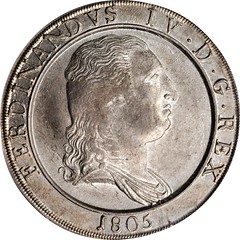
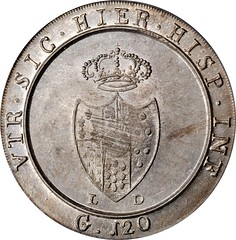
ITALY. Naples. 120 Grana, 1805-LD
To view the complete lot description, see:
www.stacksbowers.com/BrowseAuctions/LotDetail/tabid/227
/AuctionID/5000/Lot/1283/Default.aspx
Lot 2021

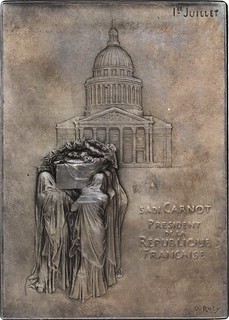
FRANCE. Death of Sadi Carnot, Assassinated President of France, 1894.
The Most Important Art Medal
58x81mm, silver, by Roty. Maier 102, Jones 323, Baxter 35. Obverse: The slain president lies in state, attended by a mournful goddess (France); above, a landscape with basilica and date; at bottom, “The Country in Grief.” Reverse: The coffin borne toward The Pantheon by females, their figures draped. Low relief, the reverse almost “misty.” A masterwork of bas relief, yet Roty takes care to make an excellent, tiny portrait of Carnot.
The plaquette form had been little used since the Renaissance, when it was nearly always uniface, with mythological and religious themes predominating. Roty’s two-sided rectangular medal was a great success with the public, as it should have been, simply because it was great art and captured the mood of the shocked and saddened nation. Further, the low, painterly relief, on a piece of the same canvass shape as most paintings, attracted attention from the wider arts community. Any doubt that Roty was in the first rank of French artists would not have survived the appearance of this piece; three years later his Sower design adorned French silver coins.
If any medal/plaquette can be ruled obligatory in an Art-Nouveau collection, it is this one.
To view the complete lot description, see:
www.stacksbowers.com/BrowseAuctions/LotDetail/tabid/227
/AuctionID/5000/Lot/2021/Default.aspx
Lot 2066

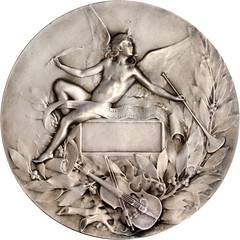
FRANCE. Orpheus, (1899).
68mm silver, by Coudray. Maier 223. Laureated portrait of the god, holding his lyre. Reverse: Winged male angel, seated on a blank cartouche; musical instruments. The Paris Mint sold 4500 copies at the 1900 Universal Exposition (mostly bronze, of course). Truly one of the classics of Art-Nouveau, the obverse was used as a cover design for Mark Jones’ The Art of the Medal.
The cataloger has had considerable experience with this medal. It is very occasionally met with in a uniface version of large size, four inches plus. I sold one to the actor Sylvester Stallone, who was shopping for paperweights.
About 15 years ago I purchased two examples in a medals collection from the estate of a Charles Kurtz heir. He was the art director of the Louisiana Purchase Exposition, but previously was an arts official for the US exhibit at the aforementioned 1900 Paris exposition. The two pieces were likely from the 4500 sold at the Expo, but Kurtz would only have been one of many persons, immersed in the arts, who fell under the spell of the medal as art.
To view the complete lot description, see:
www.stacksbowers.com/BrowseAuctions/LotDetail/tabid/227
/AuctionID/5000/Lot/2066/Default.aspx
Lot 2073
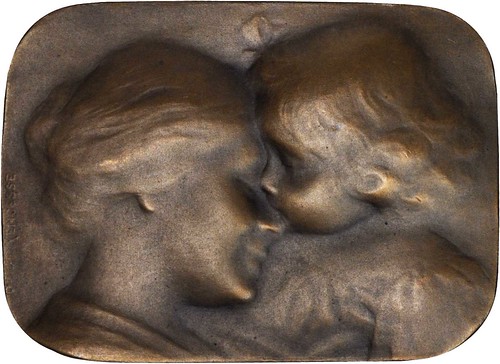
FRANCE. A Child’s Kiss, ca. 1904.
54x39mm bronze, by Ovide Yencess. Maier 195 (25x35mm), PBE 1015 (large uniface cast). Yencesse’s models were his wife and his son Hubert, who became a medalist himself. Sentimental but universal, few medals equal this in its depiction of love. This is Yencesse at his finest and most representative.
To view the complete lot description, see:
www.stacksbowers.com/BrowseAuctions/LotDetail/tabid/227
/AuctionID/5000/Lot/2073/Default.aspx
Lot 3171
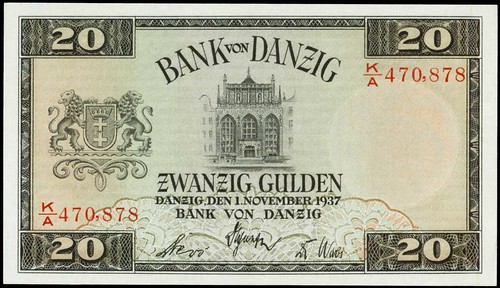
DANZIG. Bank von Danzig 20 Gulden, 1.11.1937. P-63.
An issuer which is highly popular with collectors and this example is the finest we have handled for the catalog number. The note shows with pristine original paper and color throughout and lovely centering and margins.
To view the complete lot description, see:
www.stacksbowers.com/BrowseAuctions/LotDetail/tabid/227
/AuctionID/5000/Lot/3171/Default.aspx
PRIVATE SCHULZ INSPIRED BY OPERATION BERNHARD
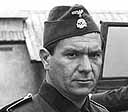 The curious case of the counterfeit cash proved to be the comic lifeblood for Private Schulz, a six-part comedy-drama series penned by the renowned Jack Pulman and transmitted shortly after his death in May 1981.
The curious case of the counterfeit cash proved to be the comic lifeblood for Private Schulz, a six-part comedy-drama series penned by the renowned Jack Pulman and transmitted shortly after his death in May 1981.
The famously bungled endeavours of German forces to flood Britain with counterfeit currency in a campaign to destabilise the British economy during wartime was of a historical circumstance always open to a darkly comic treatment, and under Pulman's experienced handling the series proved to be one of the more notable entries into BBC Television's early-1980s schedules.
The story itself concerned the release from Spandau prison of Gerhard Schulz (played by Michael Elphick), a former purveyor of "smalls" who has been in and out of prison on a relative revolving door for various fraudulent activities. Determined to serve out the Second World War from as far behind the lines as possible, he undertakes a desk job at the Postal Censorship department so as to remain clear of the hostilities and push a pen throughout the conflict.
However, the simple life he so readily pursues is soon interrupted when he is mistakenly recruited by SS Counter Espionage to serve under Major Neuheim (Ian Richardson), a man with an eye on the main chance and always prepared to serve the German cause, provided that the cause serves him to equal or additional measure. SS Counter Espionage, charged with providing the Third Reich with new and more interesting ideas and concepts on how to win the war by frustrating their enemies, proved precisely the right place for Schulz to exercise his talents: a bold plan to drop forged five-pound notes from the sky across Britain.
A thoroughly mad scheme which would only appeal to equally insane visionaries, Neuheim almost immediately claimed ownership of the idea and set Schulz to work on the detail. He employed the services of counterpart Solly (Cyril Shaps), a master forger who would ensure the success of the plan, whilst he himself wiled away his days at Salon Kitty in the company of Bertha Freyer (Billie Whitelaw), where he keep an eye trained on other people's conversations (usually from the bedroom) so as to further his own ends.
Later, Schulz undertook covert operations inside the United Kingdom, armed with the forged currency and determined to make his brainchild succeed, yet ill-at-ease with British protocol (ordering a coffee in a Public House was always going to prove to be his undoing), and upon his return to Germany he once again locked horns with Neuheim, who was quite happy to blame Schulz for the failure of the plan in equal measure to his dogged pursuit of glory at its creation. The story spanned the period from the summer of 1939 to the end of the war, with Schulz emerging as a penniless man of little or no social standing, but on the trail of a fair proportion of the forged currency he buried after parachuting into the United Kingdom in 1940.
To read the complete article, see: Private Schulz BBC 1981 (www.startrader.co.uk/Action%20TV/guide80s/prvtschulz.htm)
WARREN COUNTY PA'S WINTERFEST 2014 COIN
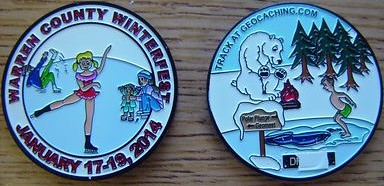
Penn Soil Resource Conservation and Development Council recently announced that it has produced and received the third souvenir commemorative coin in a collectible series to help support the cost of the annual Warren Winterfest event. The creation of the collectible coin series which began with the 2012 Winterfest event is a step toward making the Winterfest event a financially sustainable event, said Wes Ramsey, executive director of Penn Soil RC&D.
The 2014 Winterfest coin features a full-color minted and painted design featuring several elements of the Winterfest event, a polar bear warming itself by the fire while watching a man about to do the plunge, geocaching, artistic scenes of Chapman State Park, and a family group enjoying the new ice skating rink with various levels of success.
"It is a beautiful coin," said Ramsey, about the size of a 50-cent piece, and has a nice heavy feel to it. "This year's coin features full-color artistic and humorous scenes of Winterfest on both sides of the coin. Coin collectors and those who like artwork will really enjoy this collectible souvenir of the winterfest and it will help sustain the annual event. As an added bonus, and of interest to geocachers, the coin is trackable on geocaching.com using each coins unique tracking number."
Each year on the third weekend of January, Warren County, Pennsylvania, stages a three-day family-oriented festival - Winterfest. Located in northwestern Pennsylvania, Warren County is a Commonwealth tourist destination that caters to all outdoor recreationists who enjoy the surrounding 513,000-acre Allegheny National Forest. There is no admission fee and activities also are conducted without charge. Approximately 10,000 to 12,000 people attend this event on an annual basis.
To read the complete article, see: New Addition To Winterfest? Collectible Coin Series (post-journal.com/page/content.detail/id/633284/New-Addition-To-Winterfest-Collectible-Coin-Series.html?nav=5004)
TEENAGER FIRST AGAIN AT ROYAL AUSTRALIAN MINT IN 2014
Many collectors wish to own the first minted coin of a new year, and for one Sydney teenager luck has struck twice.
Harley Russo spent five days camped outside the Royal Australian Mint in Canberra so he could be the first to strike a coin in 2014.

Harley and his family also queued for four days at the end of 2012 so he could secure the first coin for 2013.
The annual release of uncirculated coins attracts collectors both young and old, with hundreds lining up to be among the first to mint a coin in the new year.
One keen collector even offered Harley $2,000 for his coin, which he turned down.
"It's got good value... and it will go up pretty quickly," Harley said.
The 14-year-old began collecting more than three years ago after being given coins that belonged to his grandfather.
He also won a lottery at the mint to strike the last coin of 2012.
"[I'm interested in] the designs, all the work that goes into them, and the history," he said.
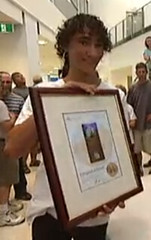 The 2014 coin commemorates Matthew Flinders' voyages charting the Australian continent.
The 2014 coin commemorates Matthew Flinders' voyages charting the Australian continent.
Mr MacDiarmid says the design is a fitting way to mark 200 years since Flinders' journal, A Voyage to Terra Australis, was produced.
"The design of the coin is actually a ship which obviously was a ship that Matthew Flinders sailed in as he was exploring Australia and circumnavigating the continent with this side of Australia on one side," he said.
Canberra's time zone also makes the first coin globally significant.
"We're obviously not the first country or nation that sees the sun rise but we are the only mint that's in the Pacific island region that actually produces a coin," Mr MacDiarmid said.
"So we'd be the first in the world."
To read the complete article, see: Sydney teenager mints first 2014 coin after camping out for five nights (www.abc.net.au/news/2014-01-01/sydney-teenager-camps-out-for-five-nights-to-mint-first-2014-co/5181214)
To read the earlier E-Sylum article, see: TEENAGER CAMPS OUT TO BE FIRST AT ROYAL AUSTRALIAN MINT SALE (www.coinbooks.org/esylum_v16n01a27.html)
THE AUSTRIAN MINT'S "PROSIT NEUJAHR" TOKENS
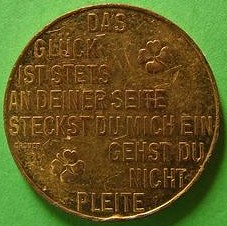

Given your current features on seasonal matters in The E-Sylum, e.g. turkeys in numismatics and money on postcards, may I bring to your attention the 1982 piece in the Austrian Mint's long series of "Prosit Neujahr" tokens, commencing c.1933. Pictures attached, and pity any poor cataloguer tasked with describing it for an auction; it is not everyone who would have the temerity to write:
"Obverse: Donkey vomiting and excreting money" !!!
Before the tokens, the Prosit Neujahr tradition produced large numbers of postcards, starting probably somewhere around the 1890s {and certainly by 1900), and these were abundant during the early years of the 20th cent. Money features with moderate frequency, in various forms; you have illustrated an example already, which is certainly not one-off, and I attach a scan of another.
For more about the Austrian Mint's Prosit Neujahr tokens, please visit Dale Hallmark's excellent site at www.austriancoins.com/tokensmint-1.html .
To read the earlier E-Sylum article, see:
POSTCARDS AND NUMISMATICS: HAPPY NEW YEAR!
(www.coinbooks.org/esylum_v16n53a26.html)
FEATURED WEB PAGE: WRONKER PRINTING MEDAL COLLECTION
This week's Featured Web Page is the Printing Medal Collection of Erich Wronker, suggested by Scott Miller, who writes:I was doing a search on the internet and came across this website about Erich Wronker's printing medals. Another section refers to Lili Wronker's stamp collection.
From the exhibition page:
A collection of printers' medals is interesting not only because it offers a visual record of great printers and of events in printing history, but also because the very art of making medals is closely connected with the beginning of printing
Erich Wronker was born in 1921 in Frankfurt am Main and grew up in the small German town of Koenigstein. In 1933 the Nazis forced the family's flight to Paris, where he attended secondary school. The family then left for Cairo, and soon afterward Erich went to Palestine, where he studied agriculture. His studies there were interrupted by war, and he was drafted by the British and served in the Jewish Brigade. During and after World War II he helped many concentration camp survivors to relocate and reunite in Palestine. He served in the Israeli Defense Forces, but declined an offer to be trained as a diplomat. After the war, while living in Haifa, his interest and knowledge of Judaica, archaeology and numismatics took shape and began to grow.
In 1955 Erich bought a Chandler & Price platen press and began producing books, greeting cards, stationery, and proofs for book jackets and exhibits. He also taught typography and letterpress printing at the Cooper Union, was a founding member of the American Printing History Association, a member of the Typophiles, and a Fellow of the American Numismatic Society. He became an expert on printers' medals, awards, coins and badges, and other aspects of numismatics, and formed one of the largest collections in private hands. In 1991 he contributed an article and a portfolio based on his collection to the scholarly journal Printing History.
The Cary Collection is privileged to display a choice selection of Erich Wronker's printing medal collection, selected and curated by his wife, Lili Wronker. This online exhibition is a selection of the 108 medals that were on display at the Cary Collection in 2002.
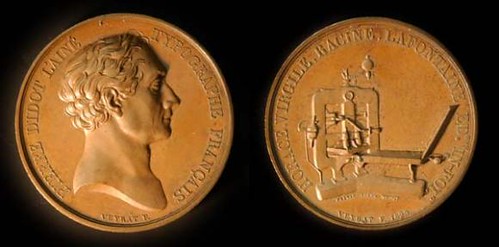
library.rit.edu/cary/exhibitions/selections
-printing-medal-collection-erich-wronker

